Brac e Hvar
27 luglio 2025
- ENGLISH VERSION BELOW -
Dopo la lunga pausa a Rogosnizza (ben 8 giorni!) non siamo ancora sicuri della rotta che vogliamo seguire: siamo infatti ormai nel clou della stagione e ci stiamo avvicinando a Trogir e Spalato da dove partono la maggior parte dei charter in questa zona. Bisogna cominciare a fare combaciare le tappe tenendo conto dei giorni di ritiro e consegna delle barche a noleggio per evitare di avere ancoraggi pieni e pericolosi. Per intanto decidiamo per una tappa intermedia per iniziare a muoverci e optiamo per Vinisce, un piccolo paesello nascosto in una profonda baia/fiordo. Arriviamo giusto in tempo prima del rinforzo pomeridiano del vento che in questo periodo porta raffiche di 20 – 25 n.
Alla fine decidiamo di saltare Spalato e Trogir memori dell'esperienza a Zara e decidiamo di infilarci nel canale tra Brac e la terra ferma che è meno battuto dai charter: infatti il grosso di essi costeggia il lato occidentale di Brac e Hvar per poi arrivare fino a Vis.
Il 12 Luglio lasciamo quindi Vinisce e dopo un lento avvio con poco vento copriamo le 17 M in 5 ore. Il nostro primo approdo a Brac è sulla costa occidentale in una piccola e bellissima baia. Per fortuna arriviamo per tempo e riusciamo a infilarci fino in fondo e ancorare alla ruota in circa 5m di acqua.
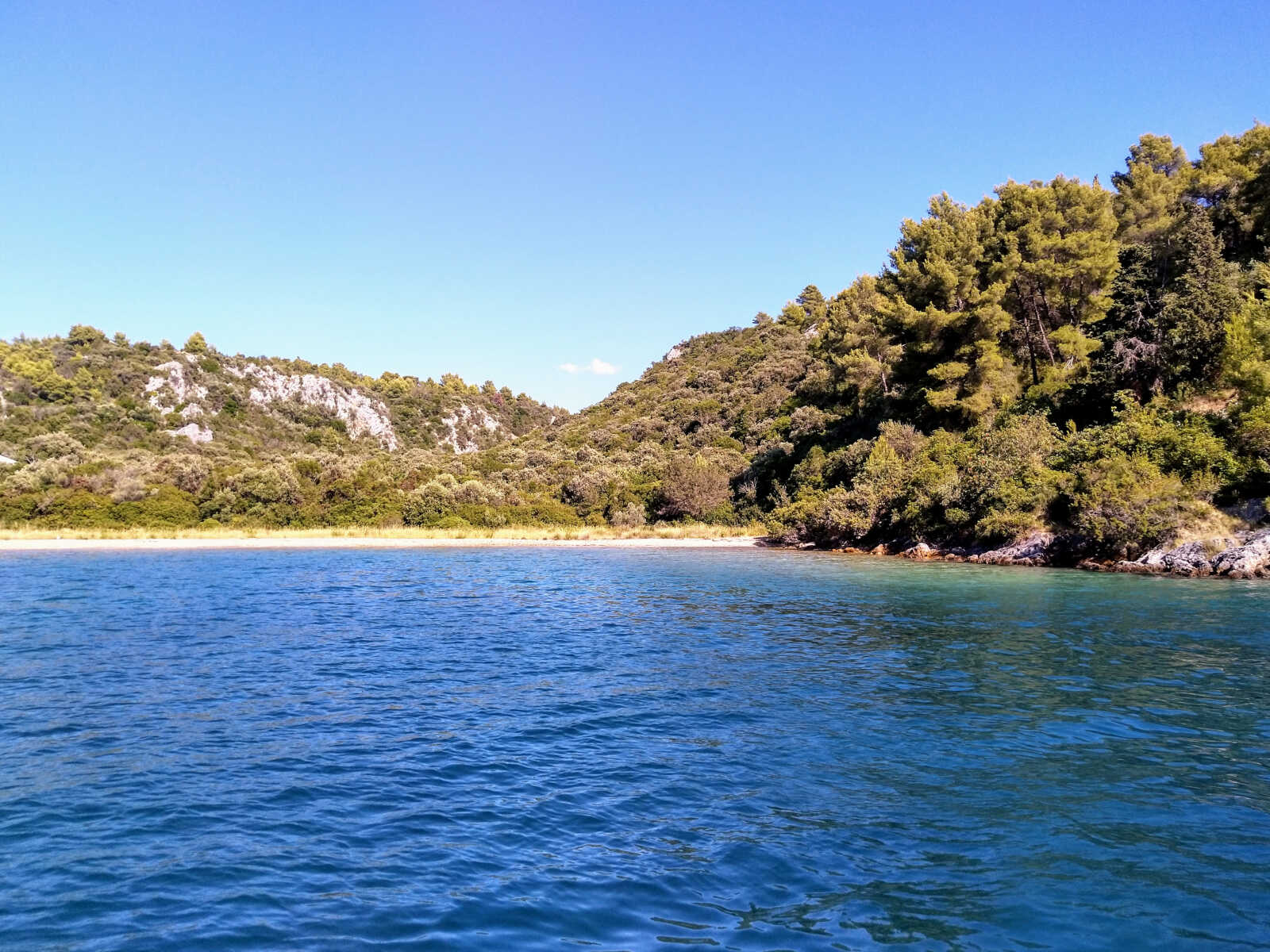
Dopo poche ore la baia viene invasa dai charter che si stipano uno di fianco all'altro con le cime a terra. Questo è un metodo molto diffuso in Croazia che consiste nel calare l'ancora e poi indietreggiare con la barca fino a riva (le coste croate sono generalmente ripide quindi è possibile arrivare molto vicini senza incagliarsi) per poi legare la poppa con due cime a terra: questo consente di piazzarsi in baie dove magari non ci sarebbe spazio per stare normalmente con l'ancora. Questo comporta anche dei pericoli perché in caso di un cambio di vento o ancora peggio di un improvviso Neverin (improvviso temporale estivo da NO tipico della costa dalmata con venti fino a 50 n) ci si può trovare con il vento al traverso e nel caso di un cedimento delle cime o dell'ancora ci si può trovare in una situazione molto pericolosa. Per questo evitiamo questa manovra e devo dire che finora siamo sempre riusciti a trovare il modo di ancorarci alla ruota. Le barche continueranno ad arrivare fino a notte inoltrata con non pochi pericoli e lasciandoci alquanto perplessi su come la gente pianifichi la navigazione così alla leggera: arrivare al buio in un ancoraggio sconosciuto e così piccolo non è sicuramente prudente.
Per quanto bello fosse l'ancoraggio, decidiamo di lasciarlo già visto l'andazzo del giorno precedente.
Abbiamo come meta Pucisca, sulla costa settentrionale di Brac, ma ben presto ci rendiamo conto che anche qui la conformazione geografica ha effetti sui venti che non combaciano mai con quelli previsti: il canale di Brac si dispiega da O a E e la costa settentrionale (la terra ferma croata) è costituita da alte montagne che arrivano fin sul mare. Si tratta delle alpe Diniriche che sono praticamente un proseguimento delle Alpi lungo buona parte della penisola Balcanica (sono l'effetto dello stesso fenomeno geologico). Queste montagne creano un muro che, da quanto abbiamo potuto osservare noi, convogliano il vento verso E o O.
Naturalmente noi ce lo ritroviamo da O esattamente dalla direzione dove vogliamo andare: ci ostiniamo ad andare di bolina ma ciò significa allungare considerevolmente la strada da percorrere visto che bisogna zigzagare con un certo angolo al vento visto che non si può andare a vela controvento. All'improvviso il debole vento diventa di 25 n e ci ritroviamo a bolinare da una costa all'altra del canale. Ci rendiamo conto che non arriveremo mai alla nostra meta, in più viene diramato un allarme meteo per possibili temporali: decidiamo di trovare un ancoraggio di riserva e optiamo per U. Lovrecina. Alla fine dopo 7 ore di navigazione, 18 bordi e 24M raggiungiamo l'ancoraggio che sarebbe altrimenti distato appena 12M se avessimo navigato a motore diretti controvento.
Dopo un breve acquazzone ci godiamo la nostra cena e il tramonto in pozzetto e guardando con il binocolo la sponda opposta del canale notiamo una profonda spaccatura nelle ripide montagne attraversata da un ponte. Guardando le cartine scopriamo che si tratta della foce di un fiume che scende lungo uno scenografico canyon. Alla sua foce è situata Omis (Almissa in italiano) una cittadina che fu la roccaforte dei pirati dalmati. Siamo incuriositi e dopo aver controllato meteo e possibilità di ancoraggio decidiamo per un cambio di programma anziché continuare verso Pucisca.
Durante la colazione arriva un barcone a tema piratesco per i turisti giornalieri come se ne vedono tanti in Croazia, che si piazza attaccato a noi. Dopo una notte senza vento la nostra ancora si trovava dietro di noi esattamente sotto al barcone: informiamo della situazione la crew che ci dice che andranno via in mezz'ora. Nel frattempo tutti i turisti sono già in acqua e appena si alza un alito di vento accade ciò che temevamo e cominciamo ad avvicinarci pericolosamente a pochi metri dall'altra barca. Così con ancora la colazione in bocca decidiamo di toglierci da questa spiacevole situazione completando la manovra di disancoraggio a pochi centimetri dal barcone e redarguendo i turisti che continuano a tuffarsi in acqua fin che manovriamo.
Copriamo le 4,5M verso nord dall'altra parte del canale per ancorare a Omis. Nel pomeriggio prendiamo il tender e proviamo a risalire il fiume entrando dalla foce, attraversando il porte fluviale dove sono ancorate alla boa tutte le barche locali, infilandoci sotto un basso ponte per poi infine addentrarci per piú di 6 km nella bellissima natura così diversa dalla moltitudine di baie e isole che abbiamo visto ultimamente. La parte con il canyon si rivela essere più distante di quanto pensassimo e non ce la sentiamo di continuare con il nostro piccolo fuoribordo da 2,3 cv :).
Riscendiamo il fiume e, trovato un posto dove legare il tender, esploriamo la città vecchia di Omis: semplicemente stupendi gli scorci tra le vecchie case in pietra e le fortificazioni inerpicate sui pendii della montagna.
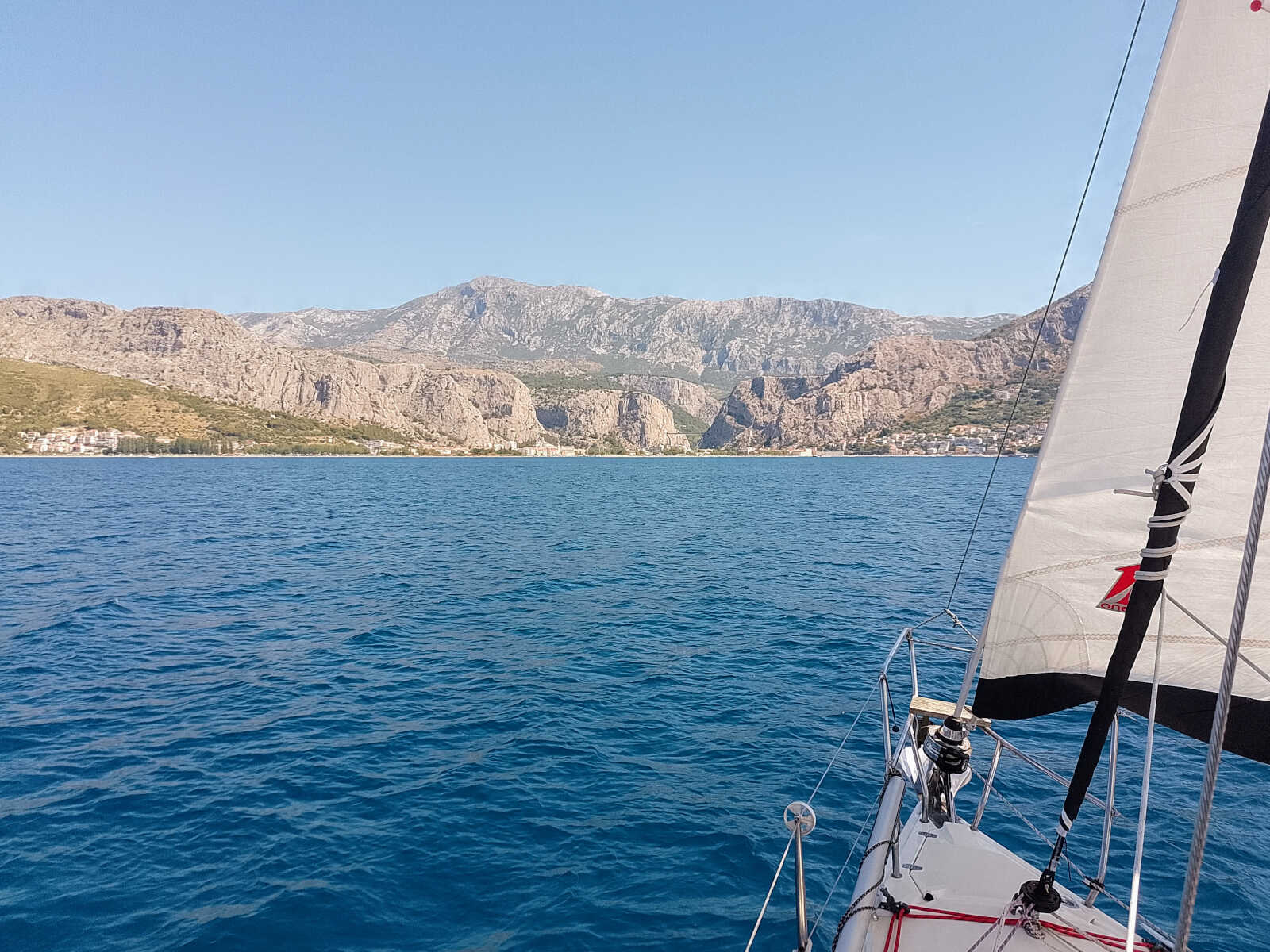
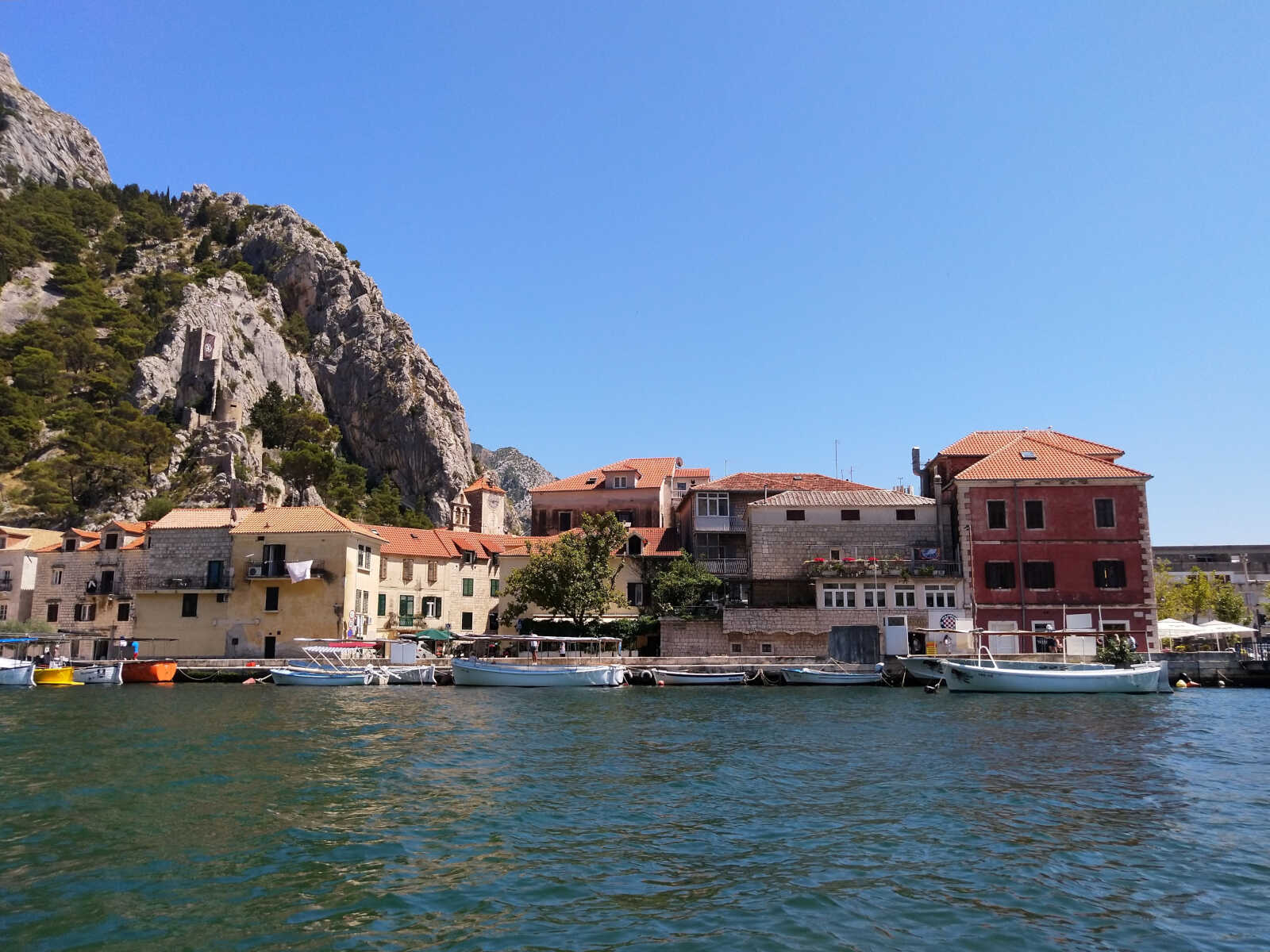


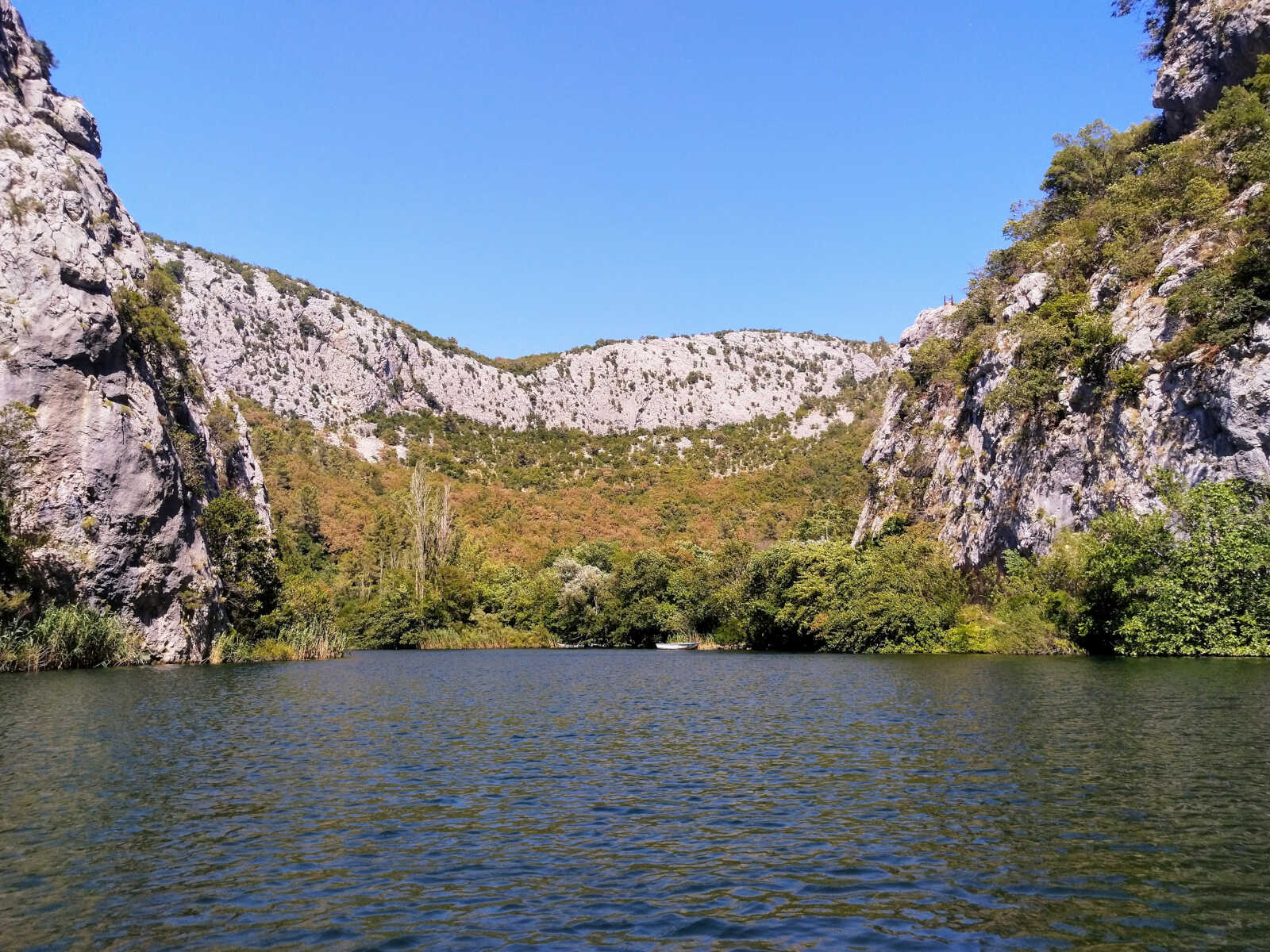
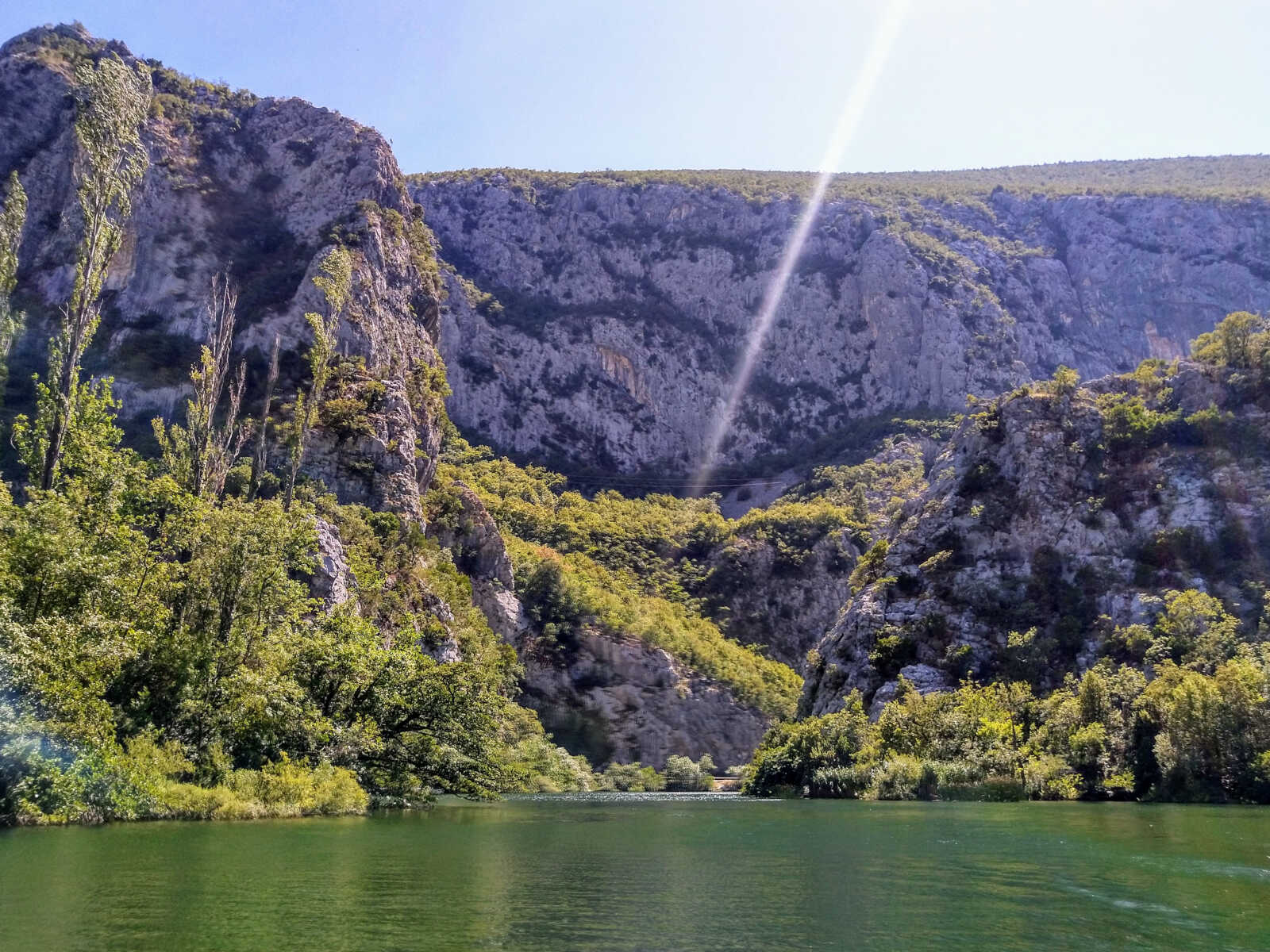
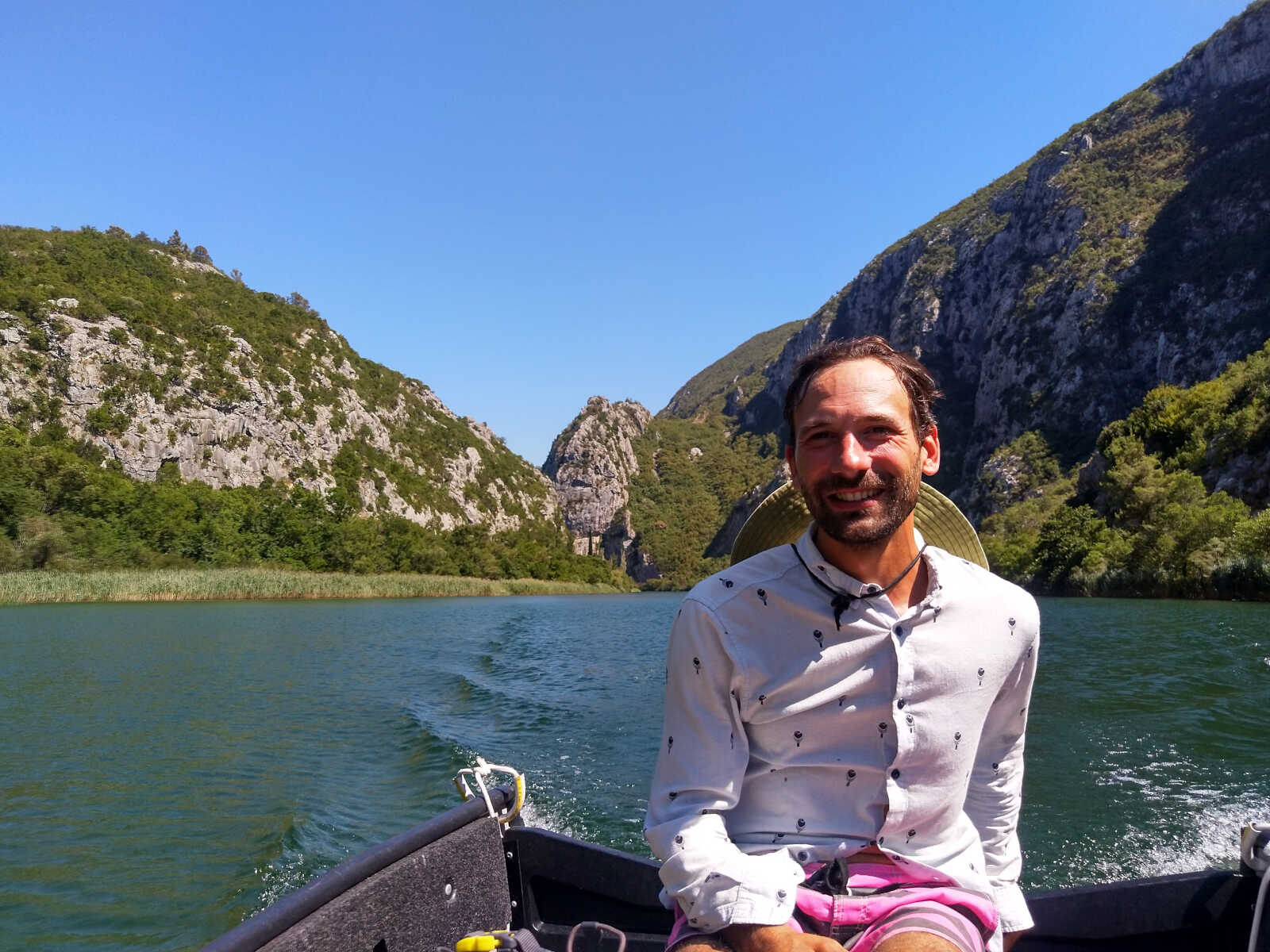
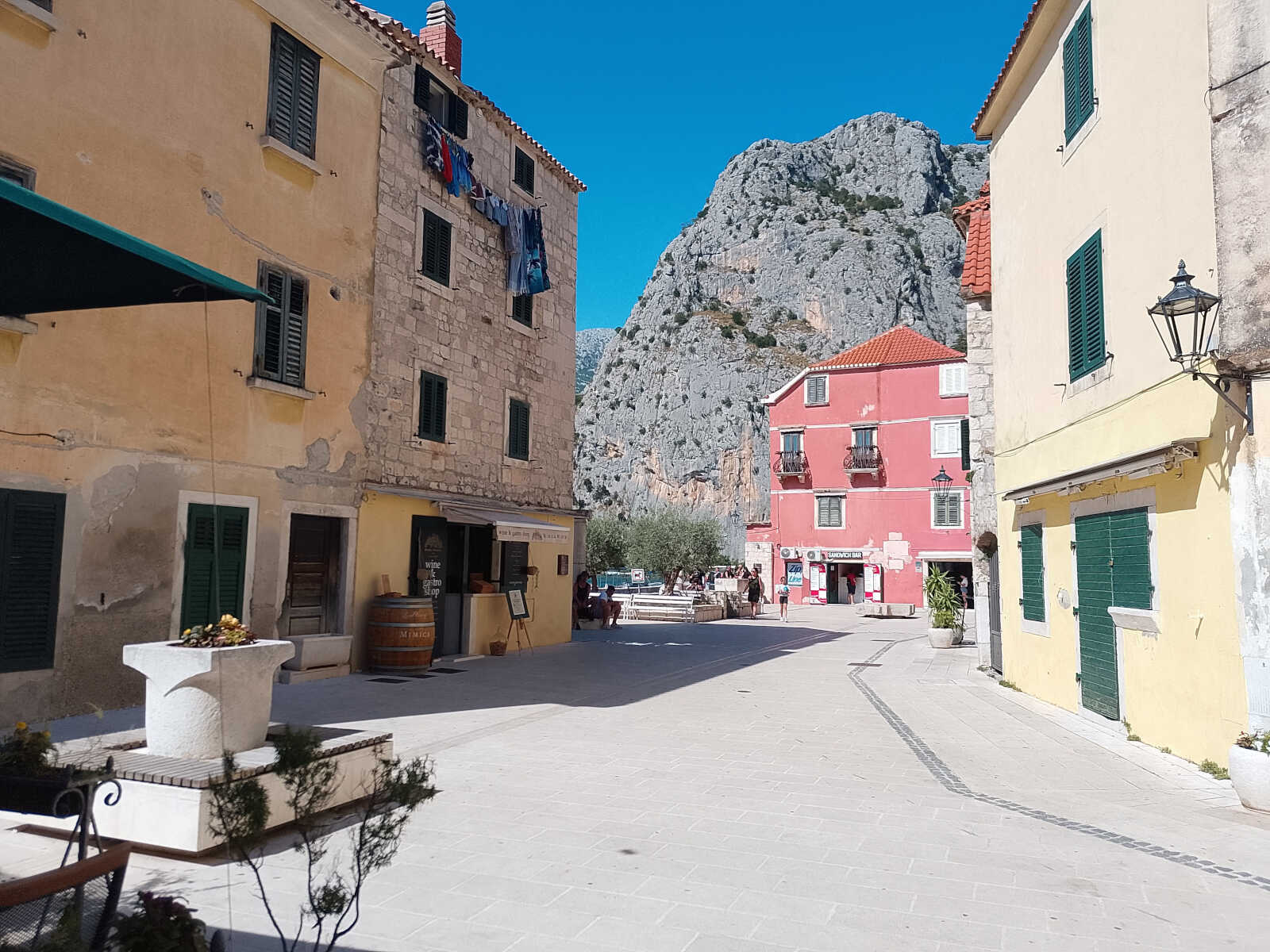
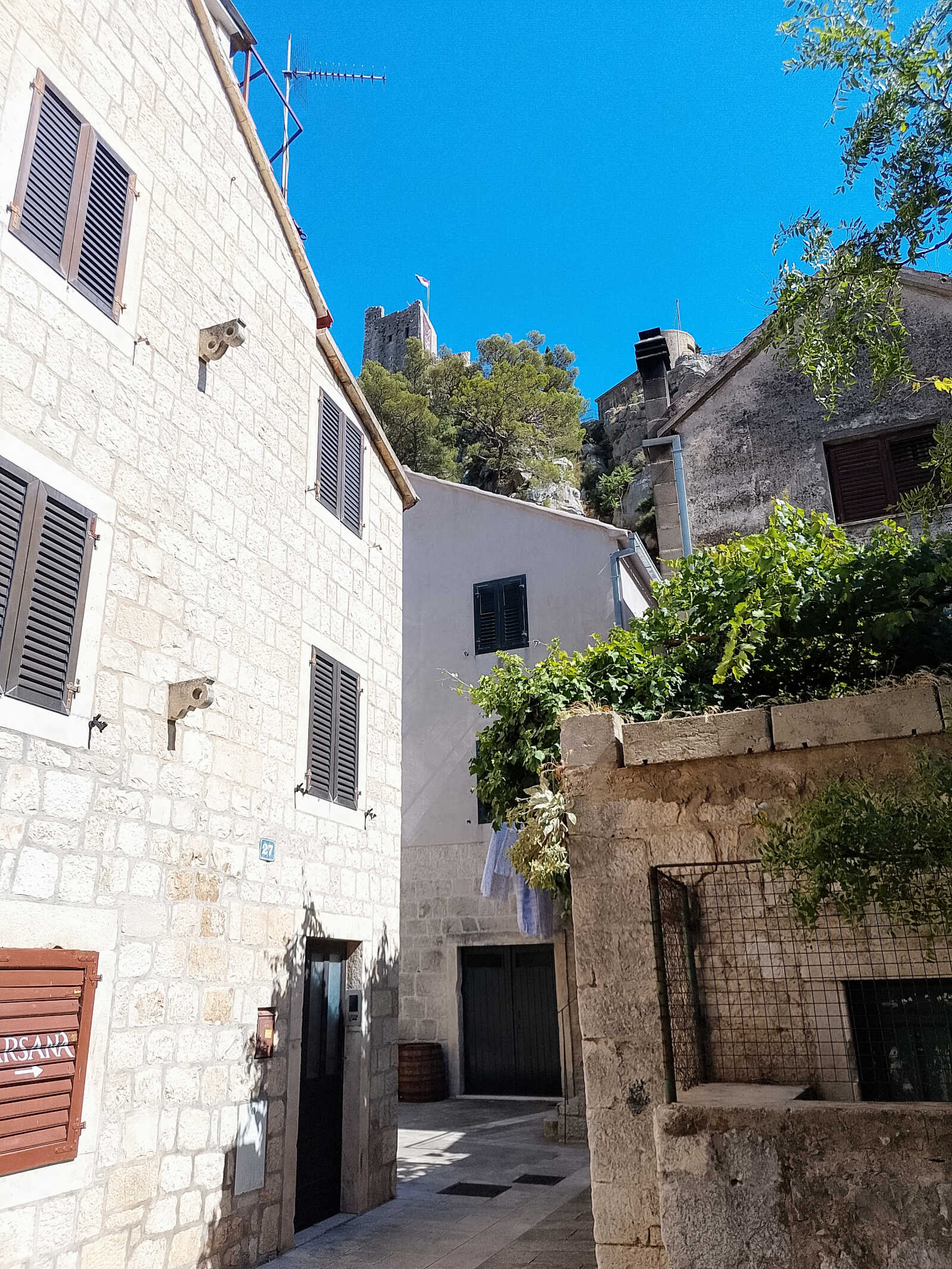
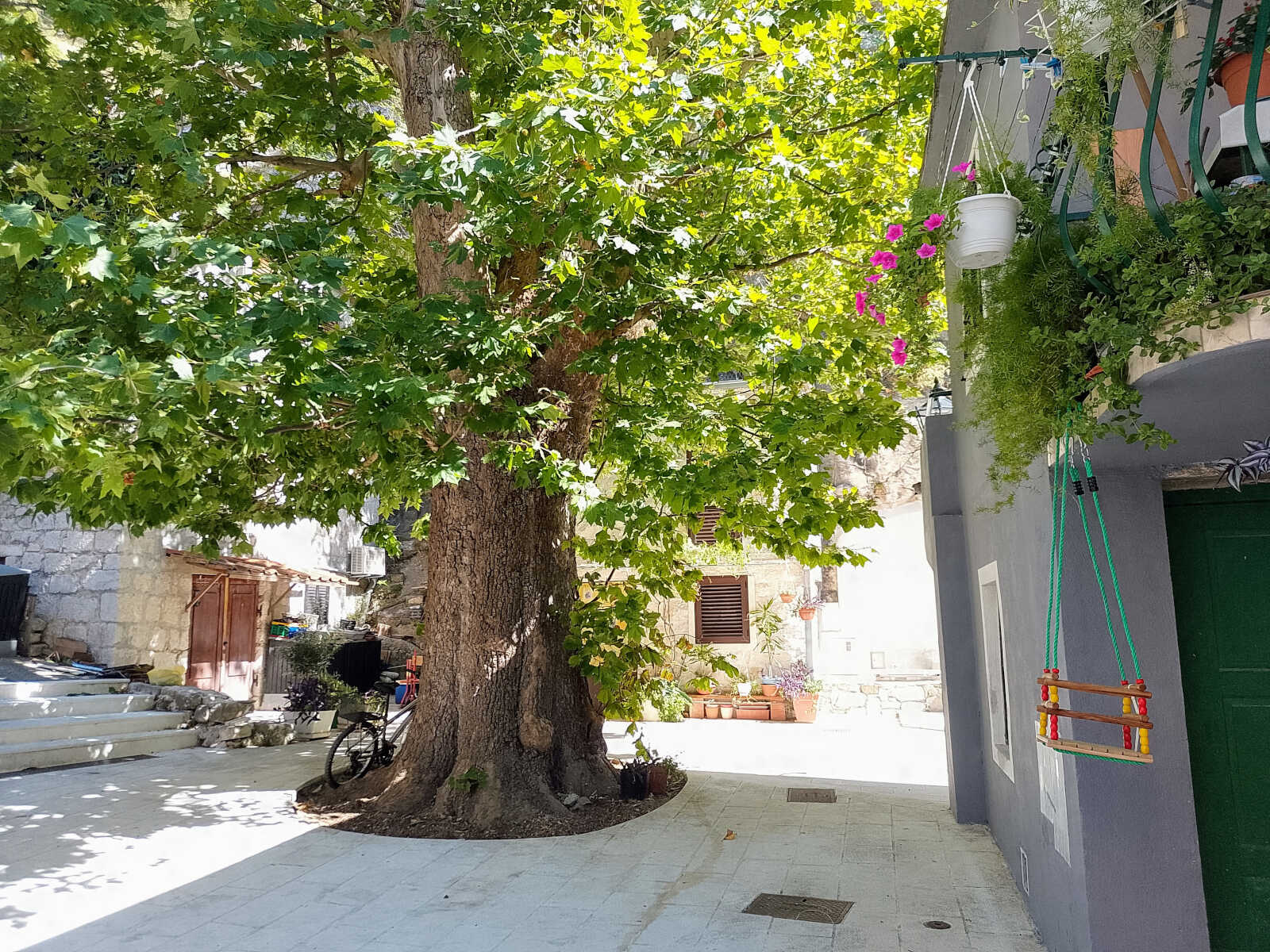
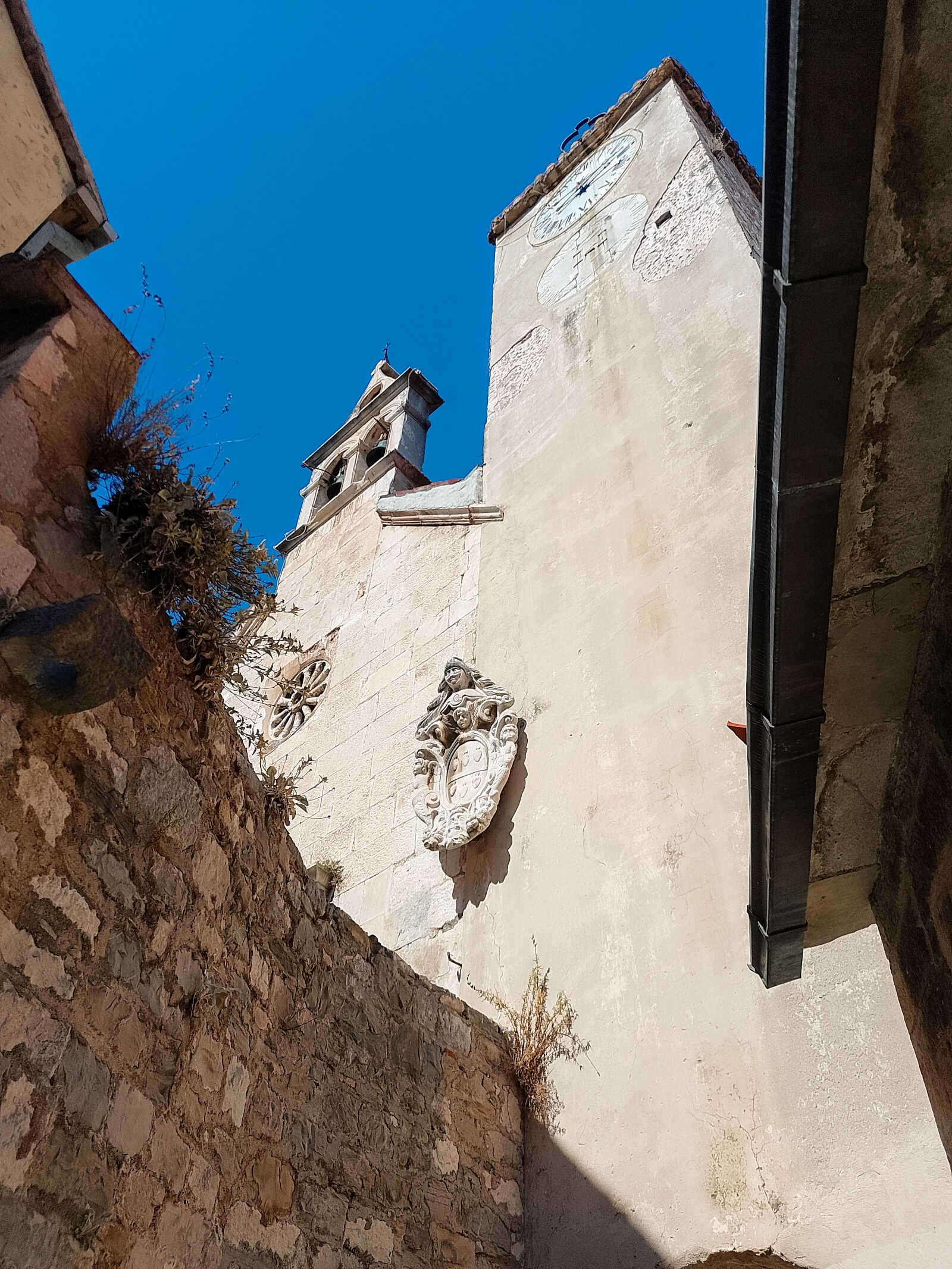
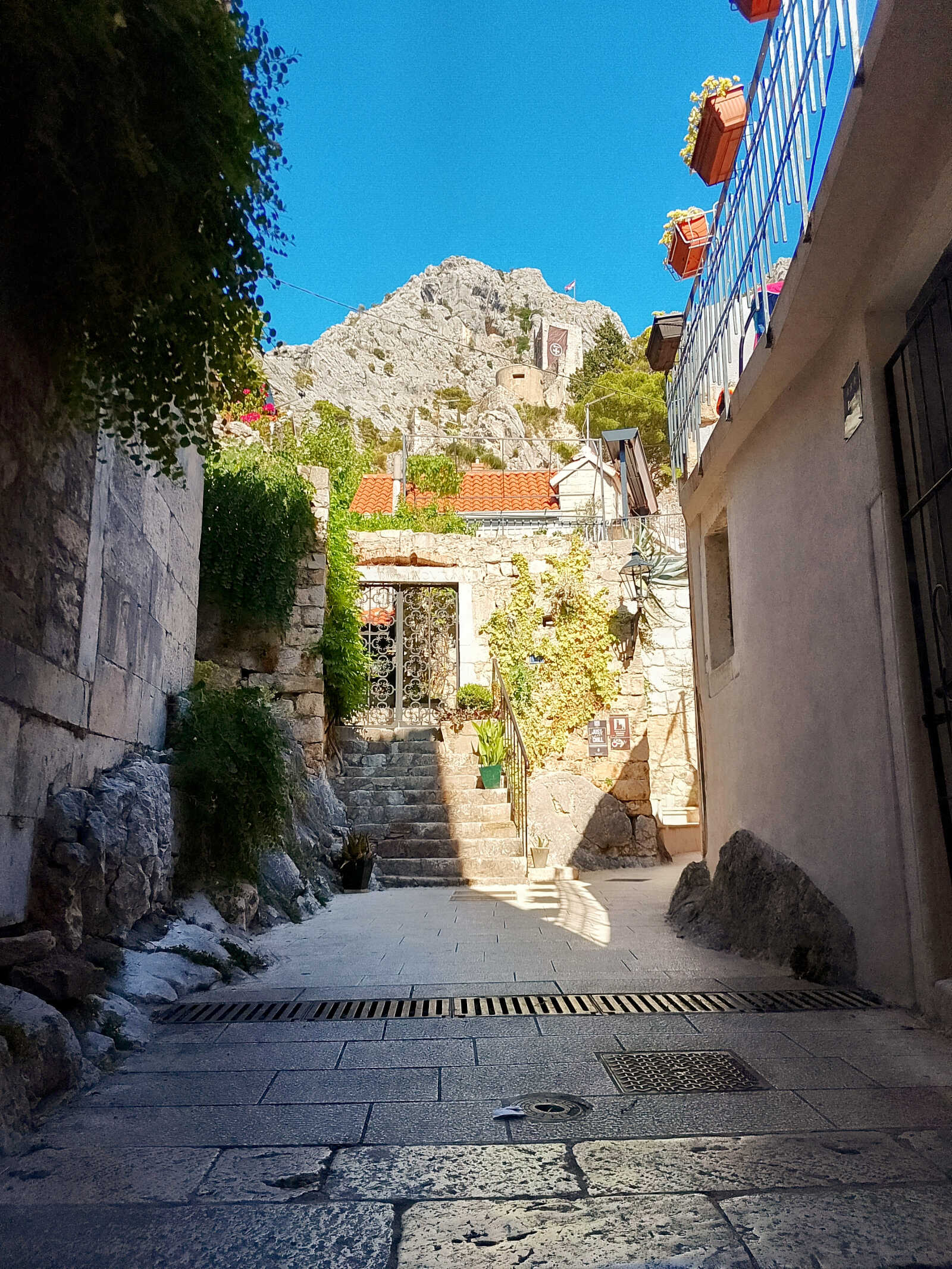
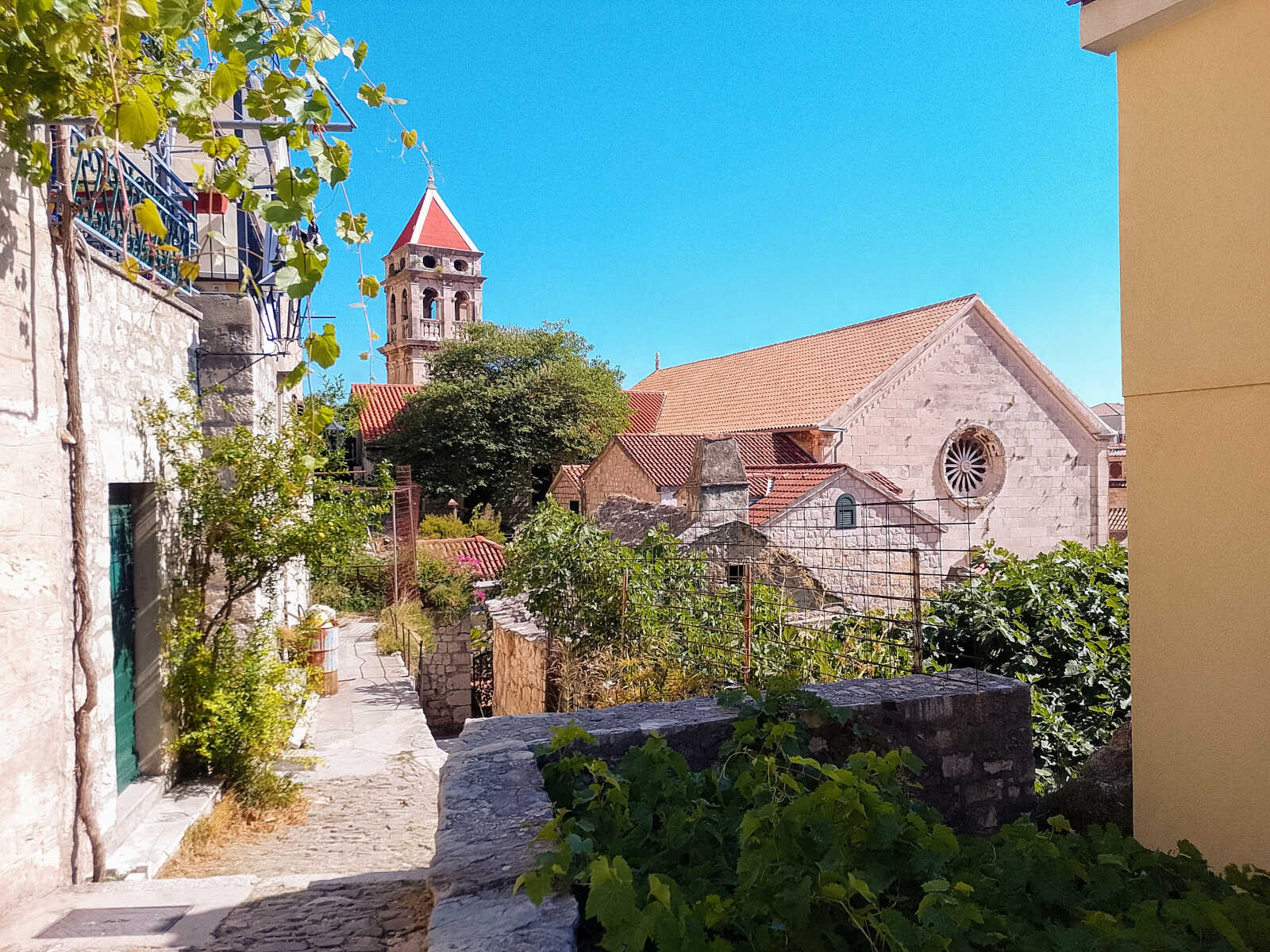
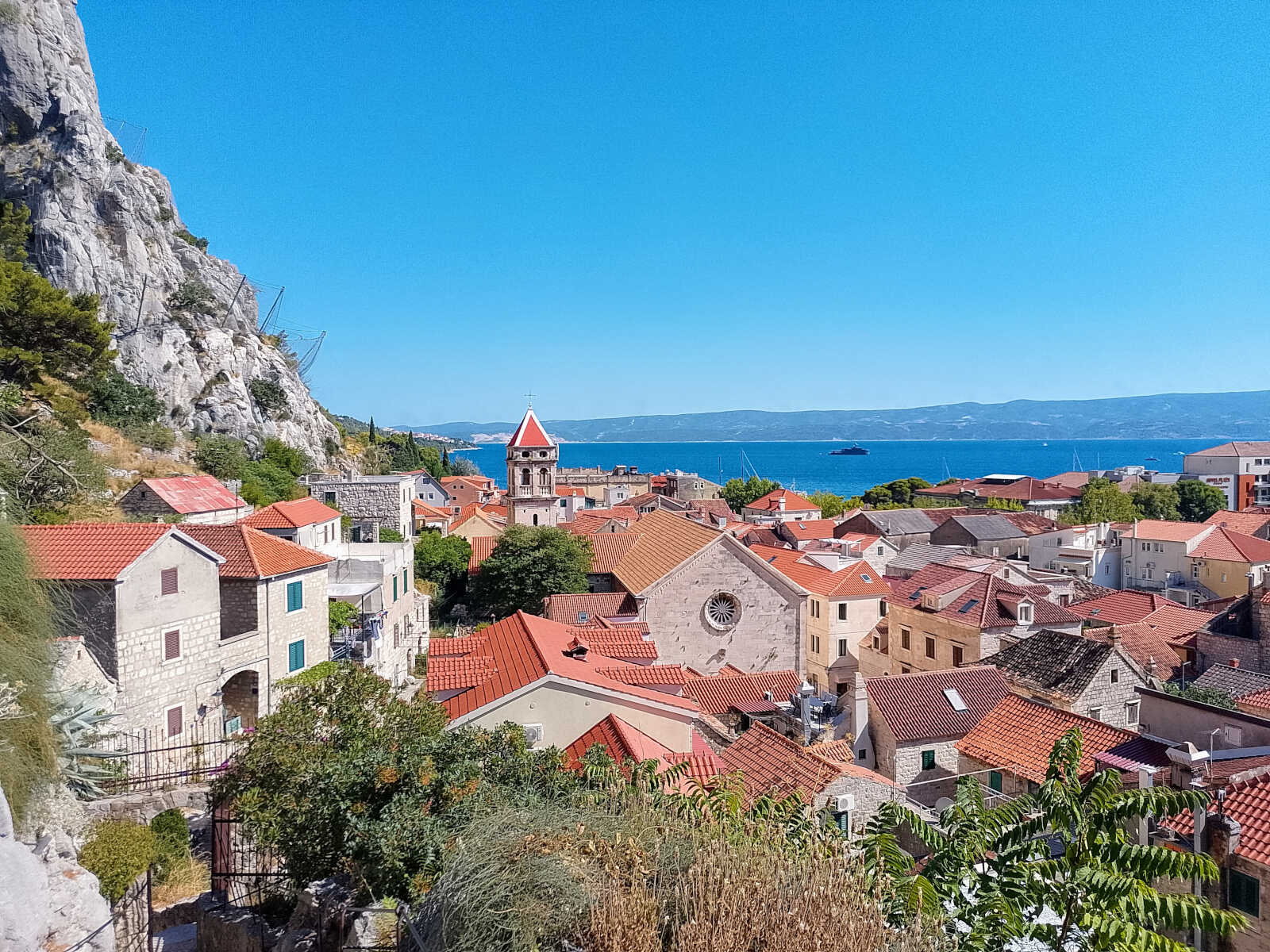

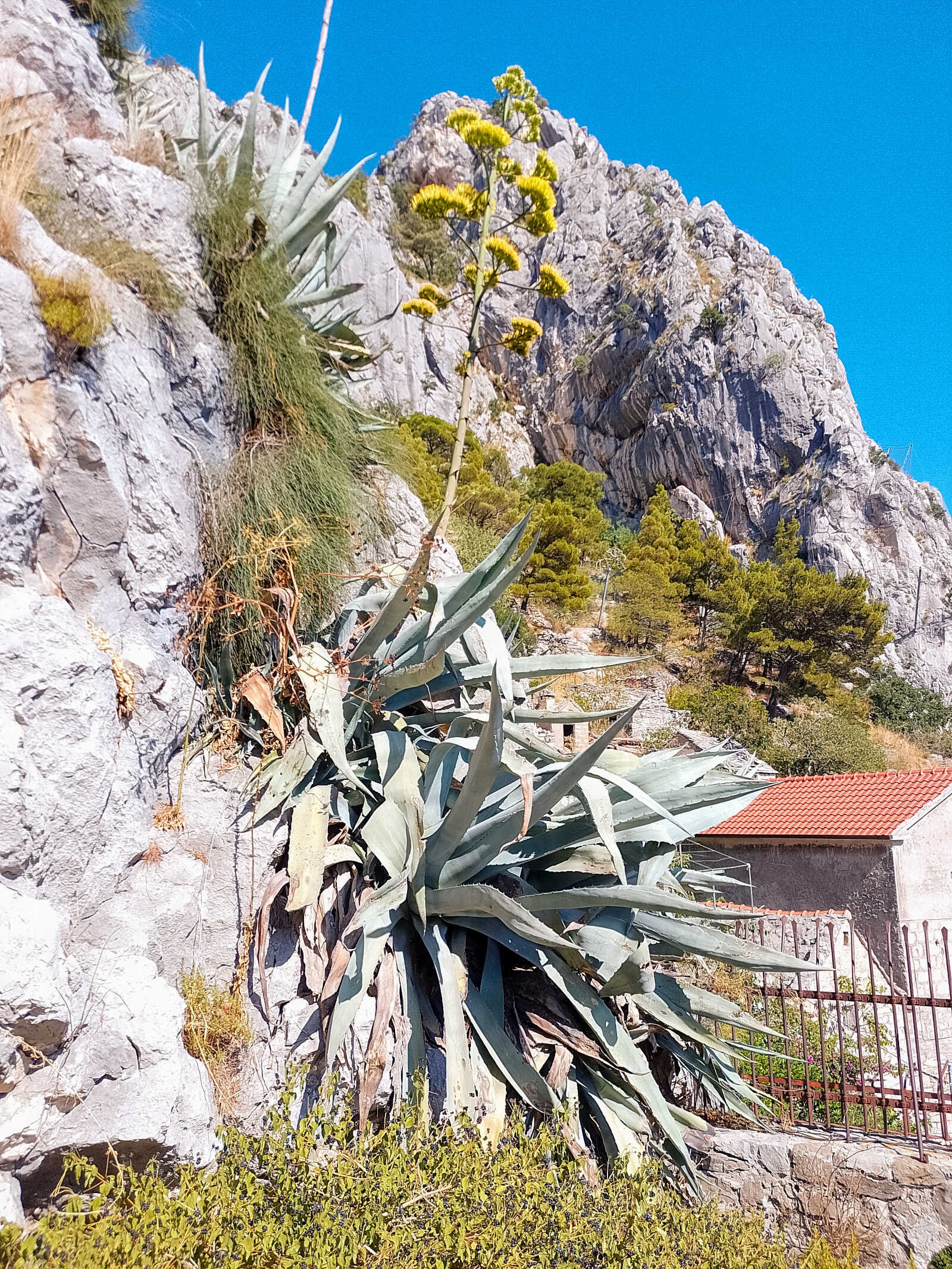
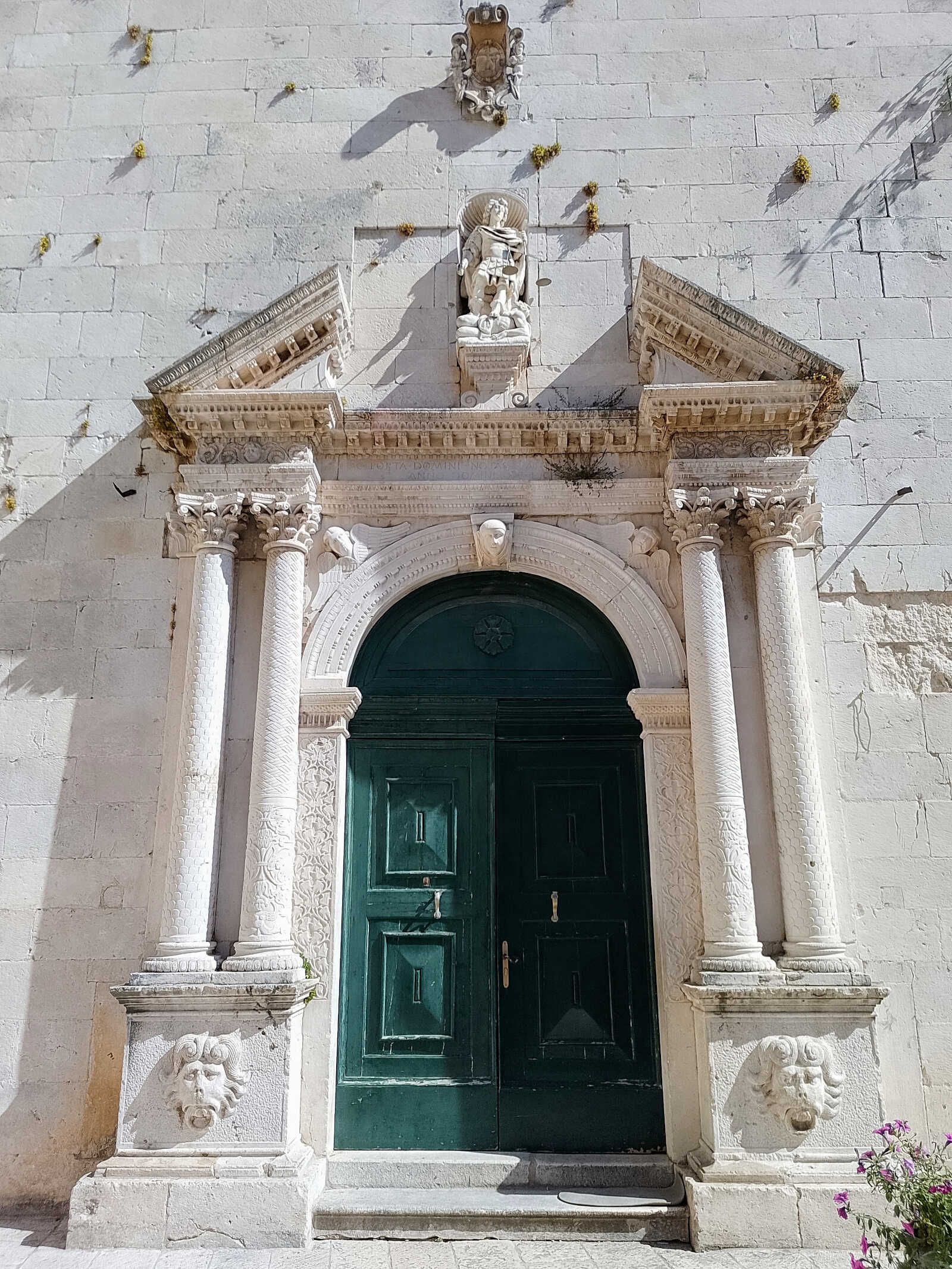
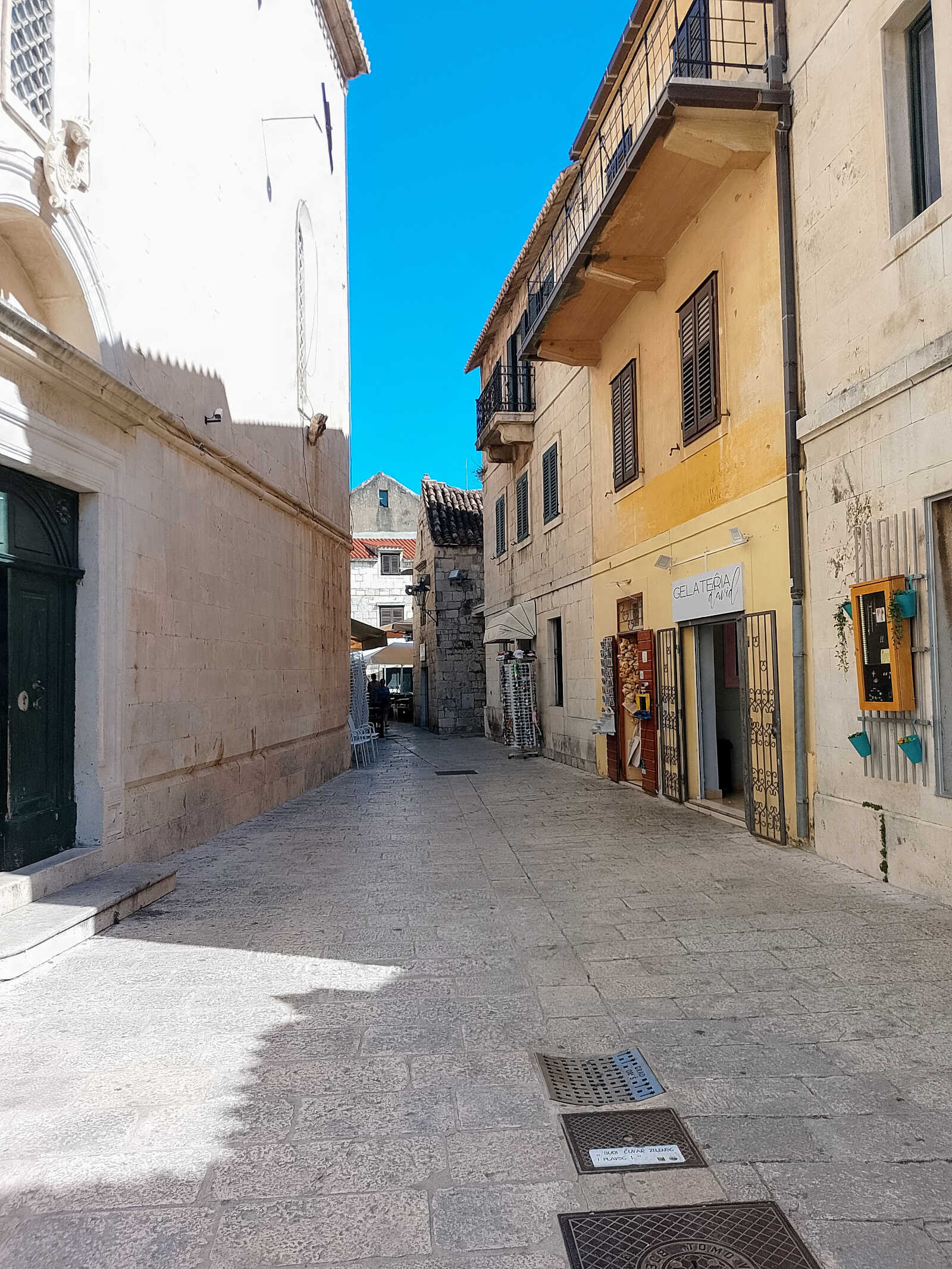
Cogliamo l'occasione per una piccola spesa e una fermata in una “pekara” (panificio) per del pane e dei Burek per cena.
Il giorno dopo copriamo finalmente le 6M che ci separano da Pucisca che si trova in una profonda baia a forma di lingua di serpente orientata a N-S. Ancoriamo nella punta a E mentre la cittadina col suo porto sono nella punta a O. In questi giorni fa molto caldo perciò decidiamo di visitare il paese alla sera. Il paesino si sviluppa lungo la riva dell'insenatura ed è un tutt'uno con il porto comunale che percorriamo gustando un rinfrescante gelato alla lavanda. Gli edifici sono tutti realizzati nella tipica pietra bianca di Brac estratta dalla cava visibile all'imboccatura della baia e qui si trova una scuola per scalpellini la cui facciata è finemente decorata. Un'altra bellissima sorpresa!
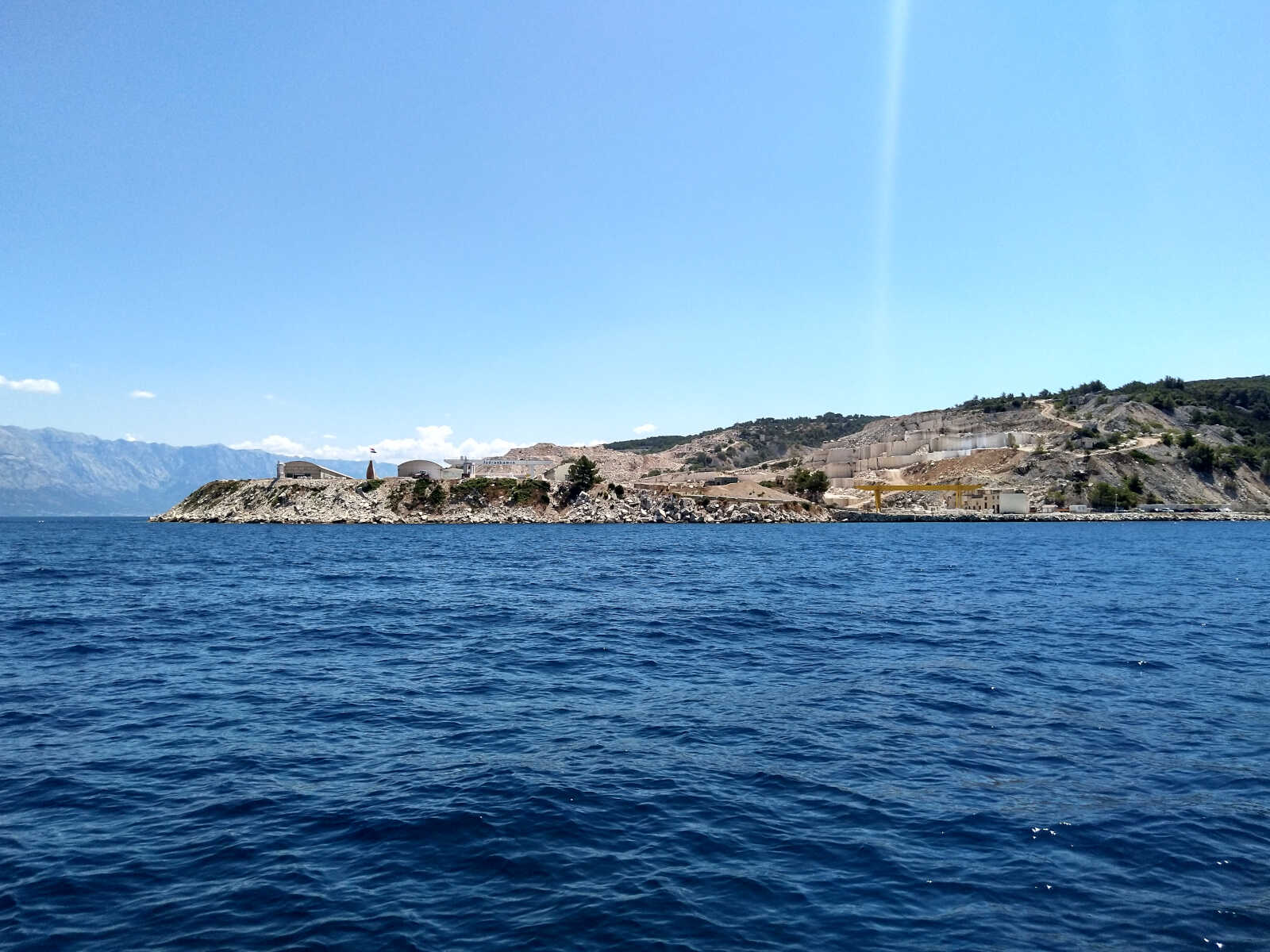
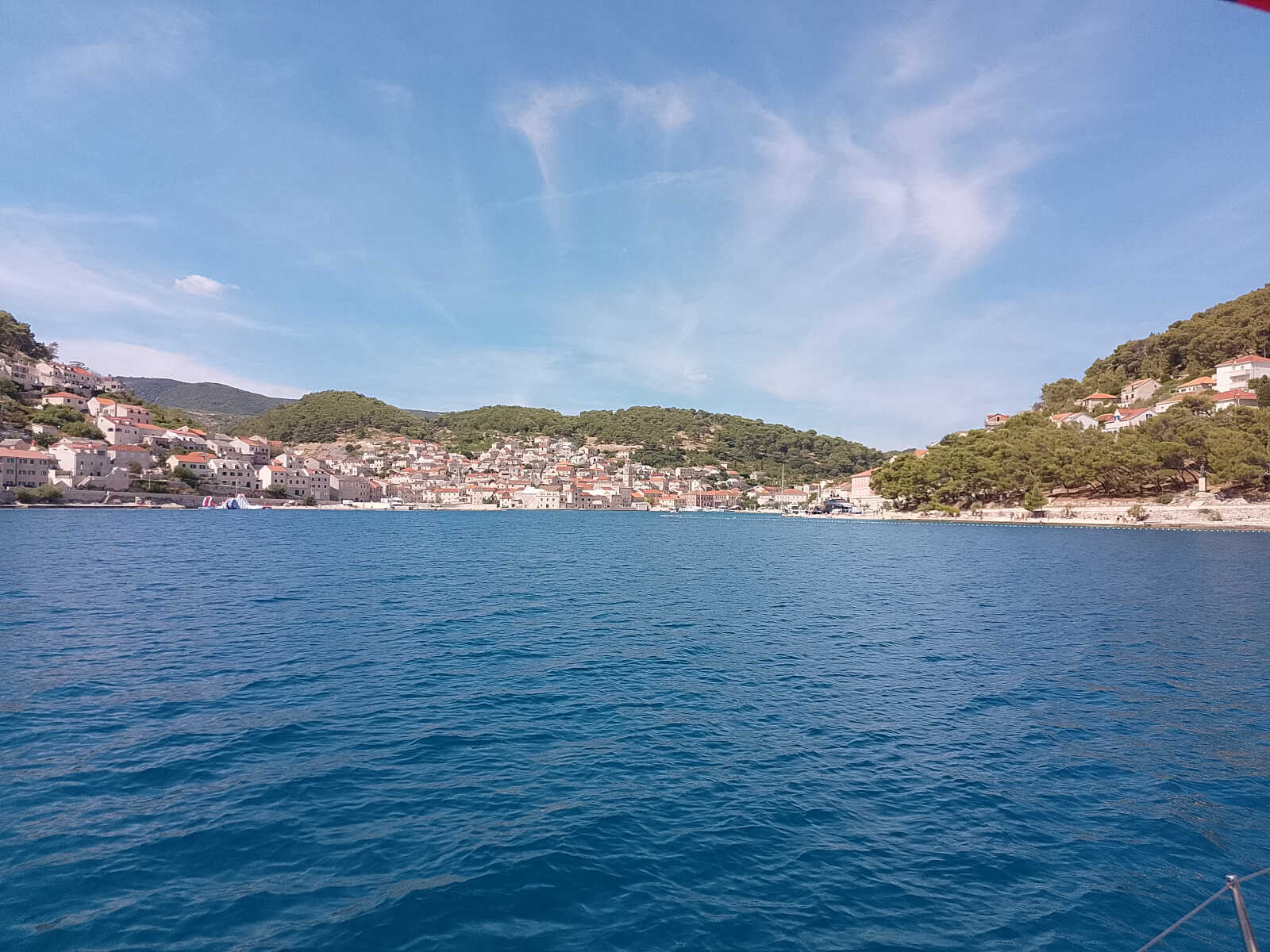
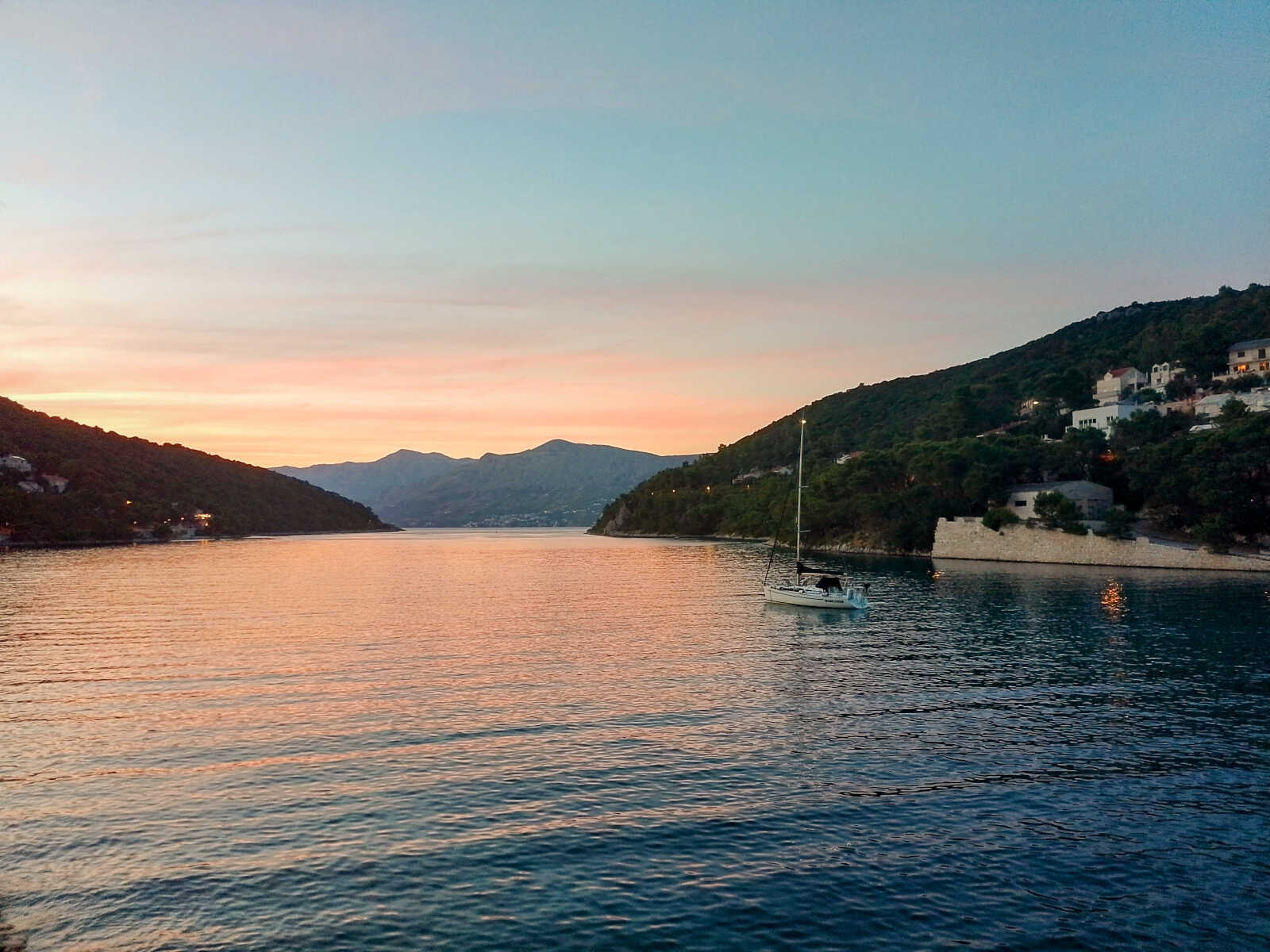

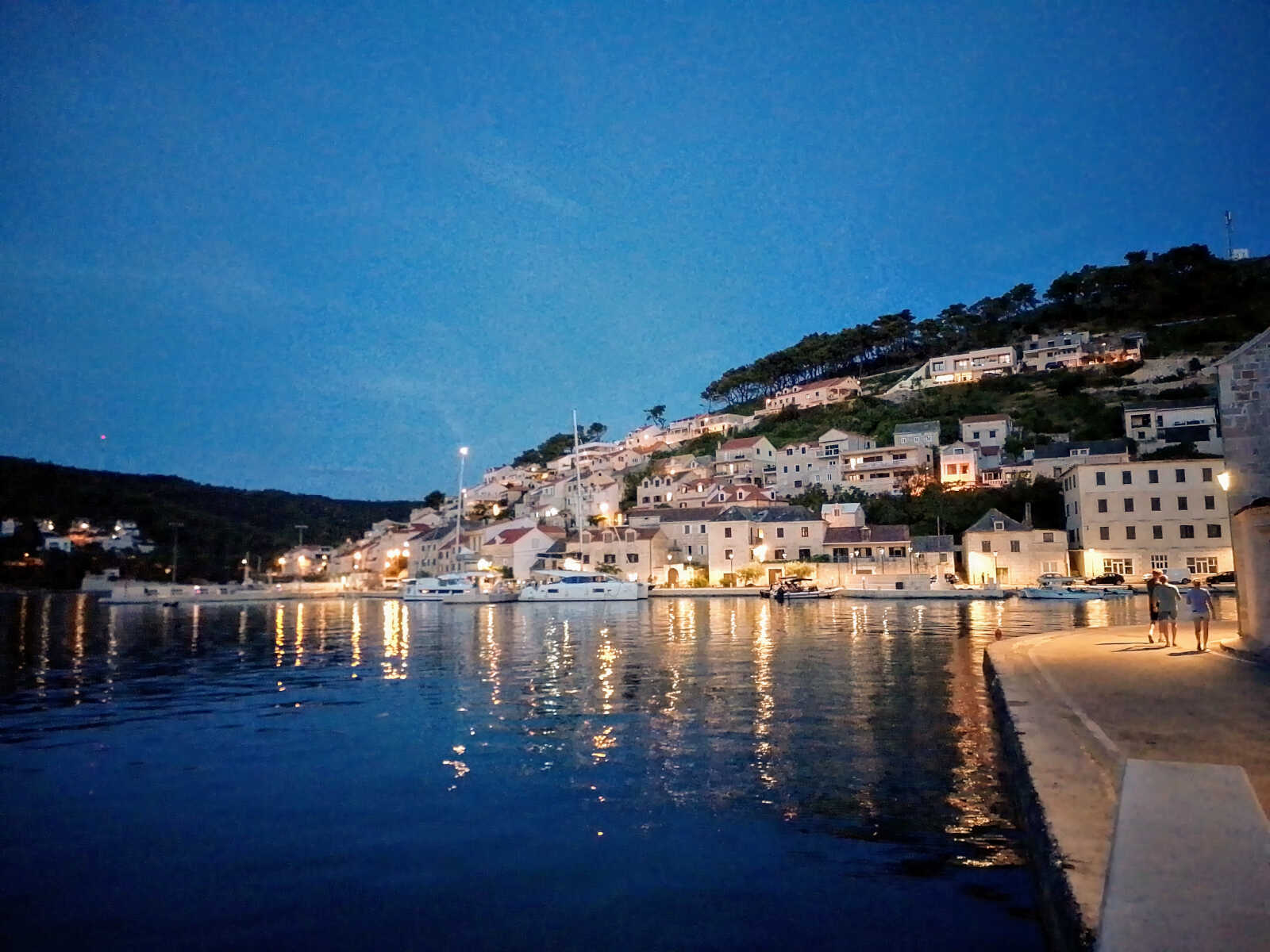
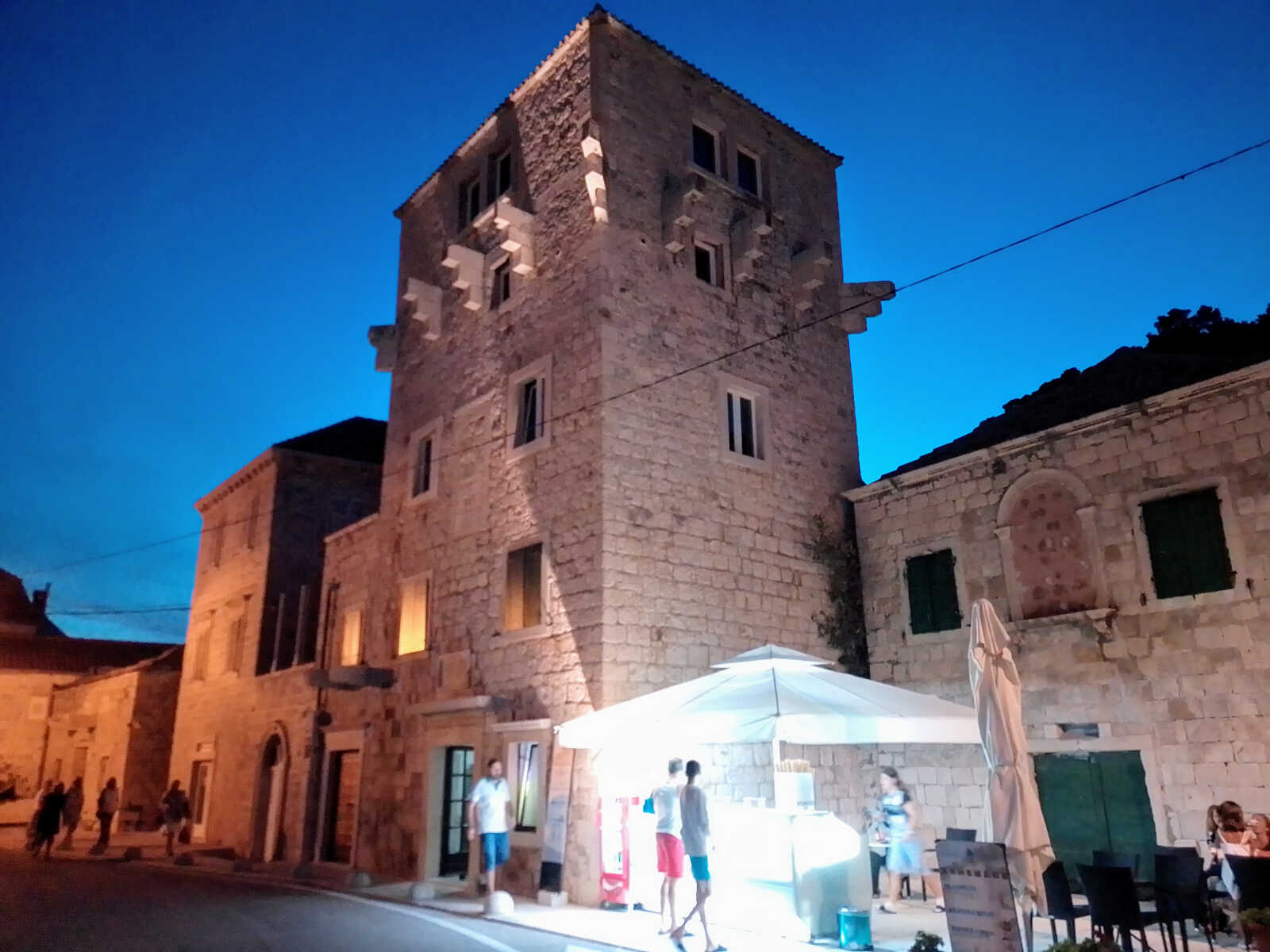

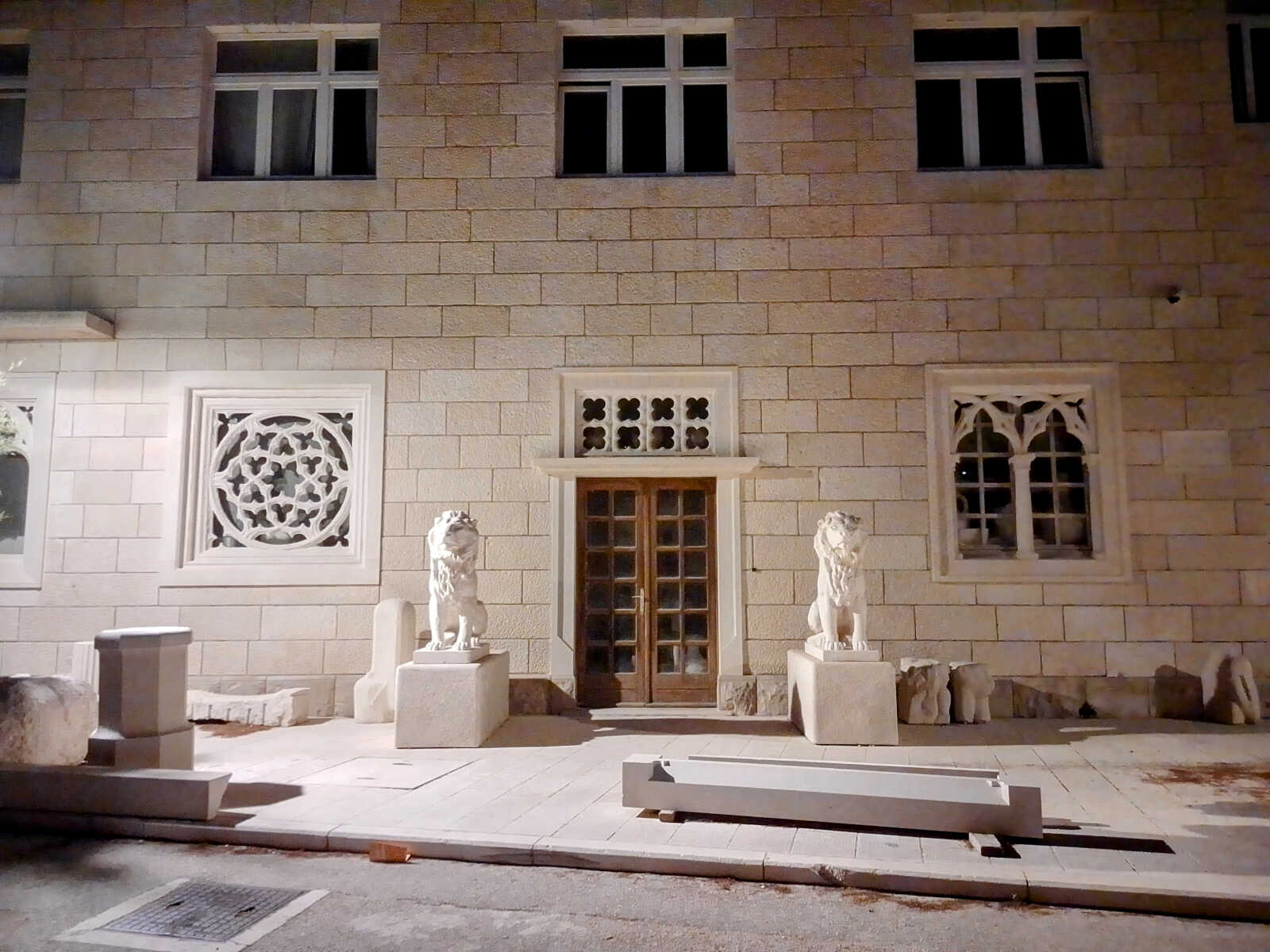
Il mattino dopo vengo svegliato dal rumore di un'ancora e come ormai d'abitudine butto fuori la testa dal passauomo della nostra camera da letto e mi ritrovo una barca a vela polacca di 43 piedi a pochi metri da noi. Esco di corsa per capire la situazione ancora mezzo addormentato e mi comunicano che hanno problemi al motore Purtroppo le barche stanno per scontrarsi quindi urlo a Melani di venire in modo da dare più catena fin che io do marcia indietro per allontanarci il più possibile da loro. Meno male ce la caviamo senza danni anche stavolta. Per stemperare la tensione vado fin da loro per offrire il mio aiuto se ce ne fosse bisogno. Dopo un po' il motore riparte: probabilmente dello sporco nel diesel.
Al di là del brusco risveglio decidiamo comunque di lasciare Pucisca nonostante avessimo programmato di stare almeno un paio di giorni perché una fastidiosa risacca ci ha fatto dormire male. Per cui continuiamo verso est lungo la costa settentrionale di Brac fino a Vela Luka. La baia è occupata da dei ristoranti che gestiscono dei campi boe ma si riesce comunque a trovare da ancorare in un angolino. Qui incontriamo una coppia di triestini che ci invitano per un aperitivo e poi addirittura per la cena in barca da loro dopo che ci siamo presi la briga di remare fino da loro per indicargli che si era liberato del posto per ancorare vicino a noi visto che avevamo notato che stavano faticando a far fare testa all'ancora in quel punto della baia dove erano loro. Si rivela una serata piacevole di chiacchiere e scambi di esperienze.
Il 18 Luglio doppiamo il capo orientale di Brac e ci troviamo una piccola baia dall'acqua azzurrissima solo per noi. Provo a pescare in apnea lungo la costa ma non ho fortuna.
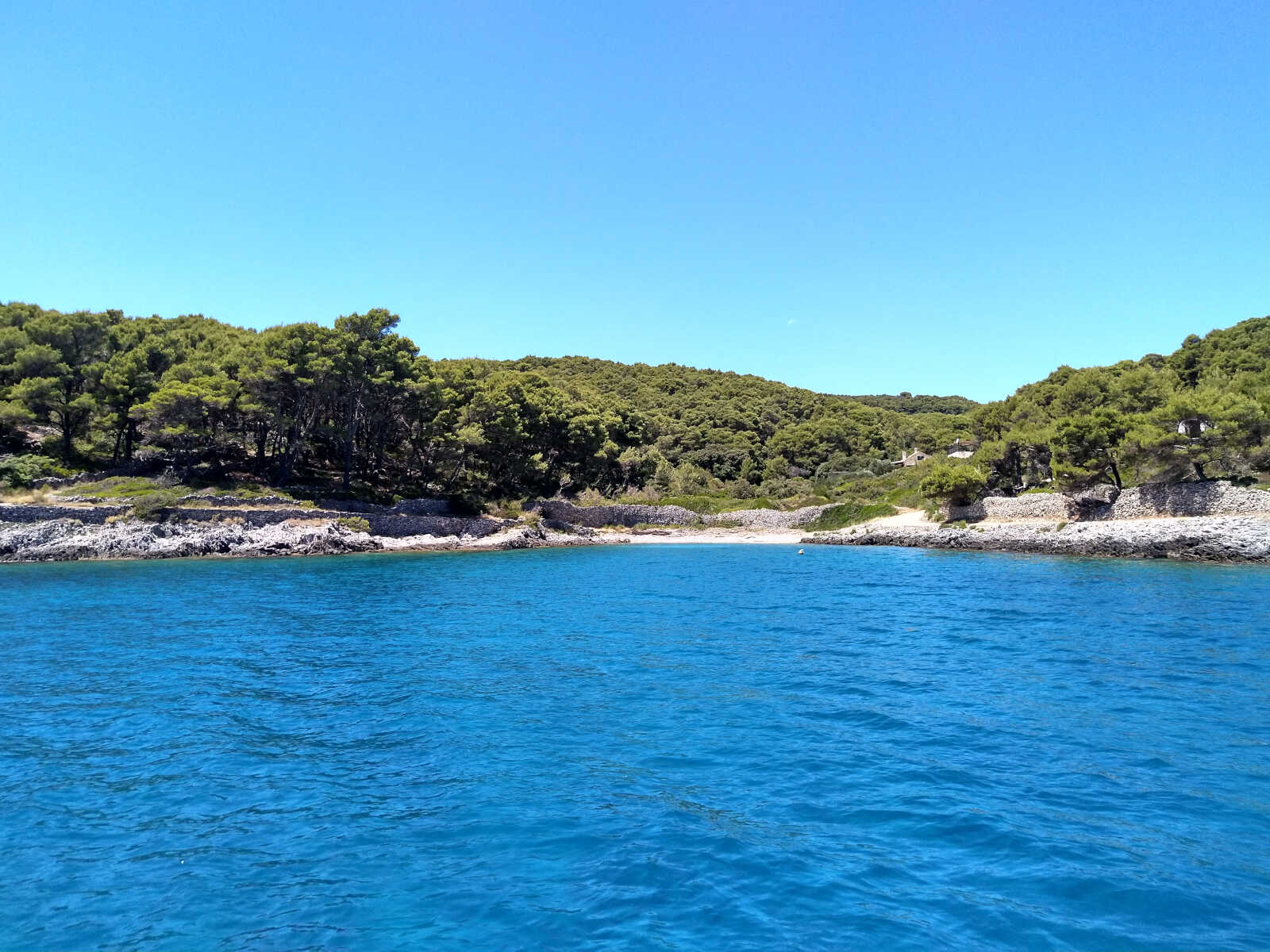
Il giorno successivo decidiamo di attraversare il canale che separa Brac e Hvar visto che il vento soffierà dai settori meridionali per i prossimi giorni e ci lascerebbe esposti se rimanessimo sulla costa meridionale di Brac. Facciamo 10M fino alla bellissima U. Kruseva: una bella insenatura dalle ripide pareti con delle grotte marine. Spendiamo 3 giorni qui e abbiamo l'ancoraggio solo per noi ogni notte e rimaniamo seduti in pozzetto fino a tardi a guardare le stelle e chiacchierare. Ne approfitto per una pulizia profonda della carena e faccio anche una bella pescata in apnea e prendo due belle orate in 5-7m di profondità
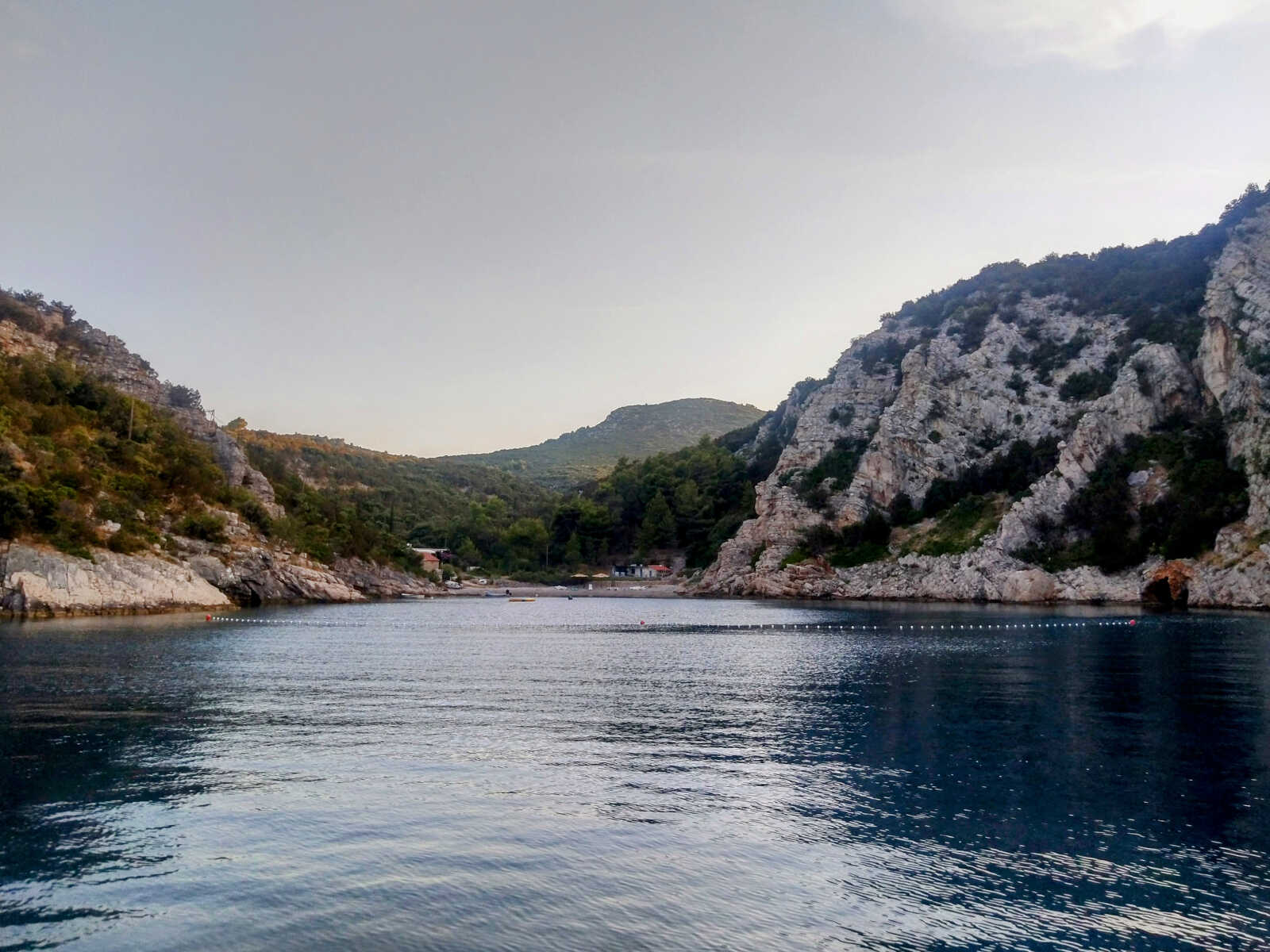
Continuiamo verso O prima dell'arrivo di forti venti da quella direzione e ancoriamo nell'ampia baia di U.Soline: c'è spazio per molte barche ma alla fine si finisce sempre molto vicini e molti sembrano faticare a far tenere la loro ancora. Comunque noi ci troviamo un bel posto e siamo tranquilli. La prima sera andiamo fino a nuoto a riva con in nostri vestiti nella sacca impermeabile e dopo una doccia in spiaggia andiamo a visitare a piedi Verboska che ci lascia impressionati dalla sua bellezza: anche qui belle case in pietra (anche se un po' diverse dalle altre che abbiamo visto finora) si sviluppano lungo un canale con dei bei ponti dalle reminiscenze veneziane, un po più su si vedono le due chiese del XV secolo di cui una, un bellissimo esempio di chiesa fortificata per resistere alle incursioni ottomane.
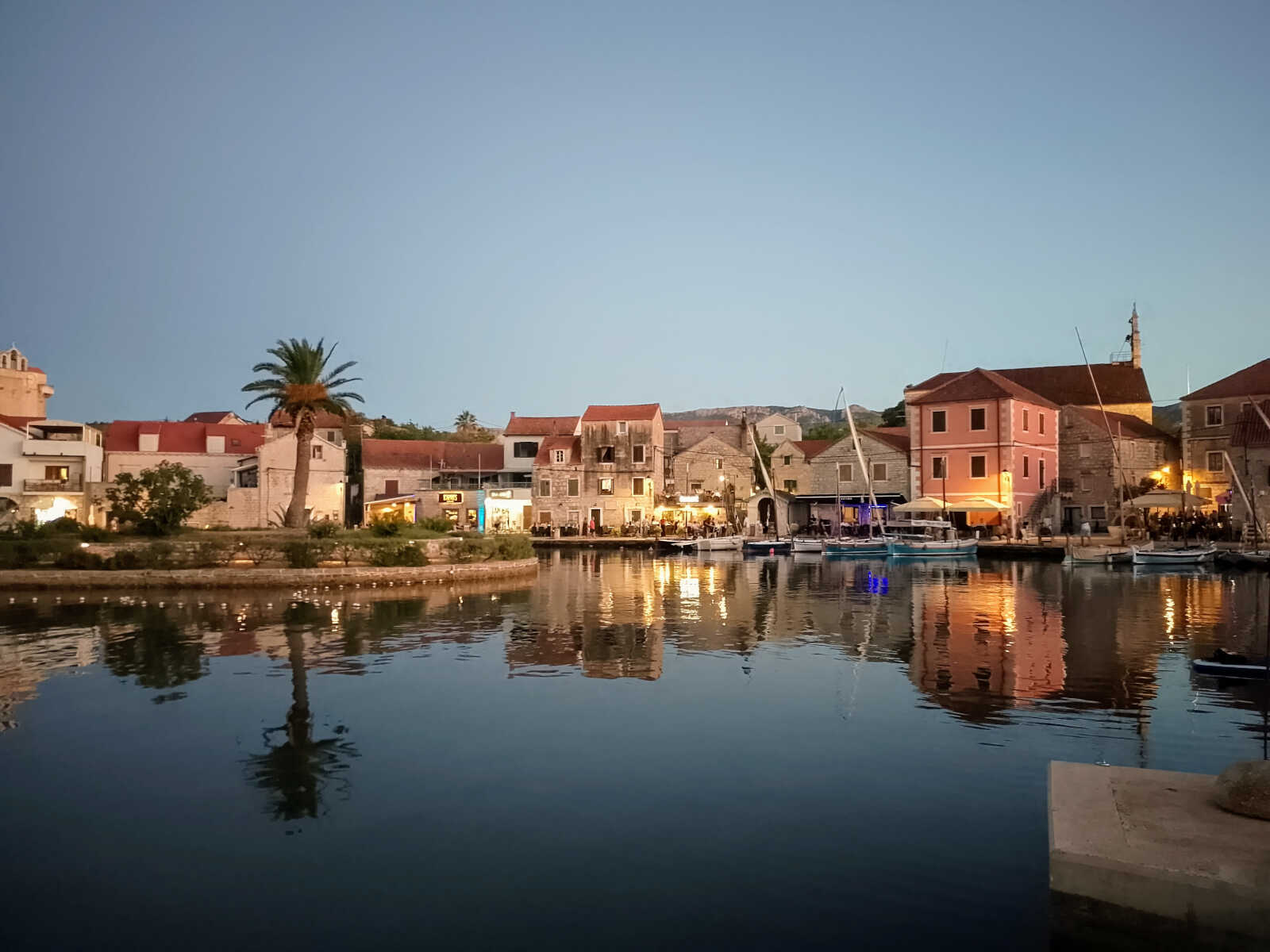
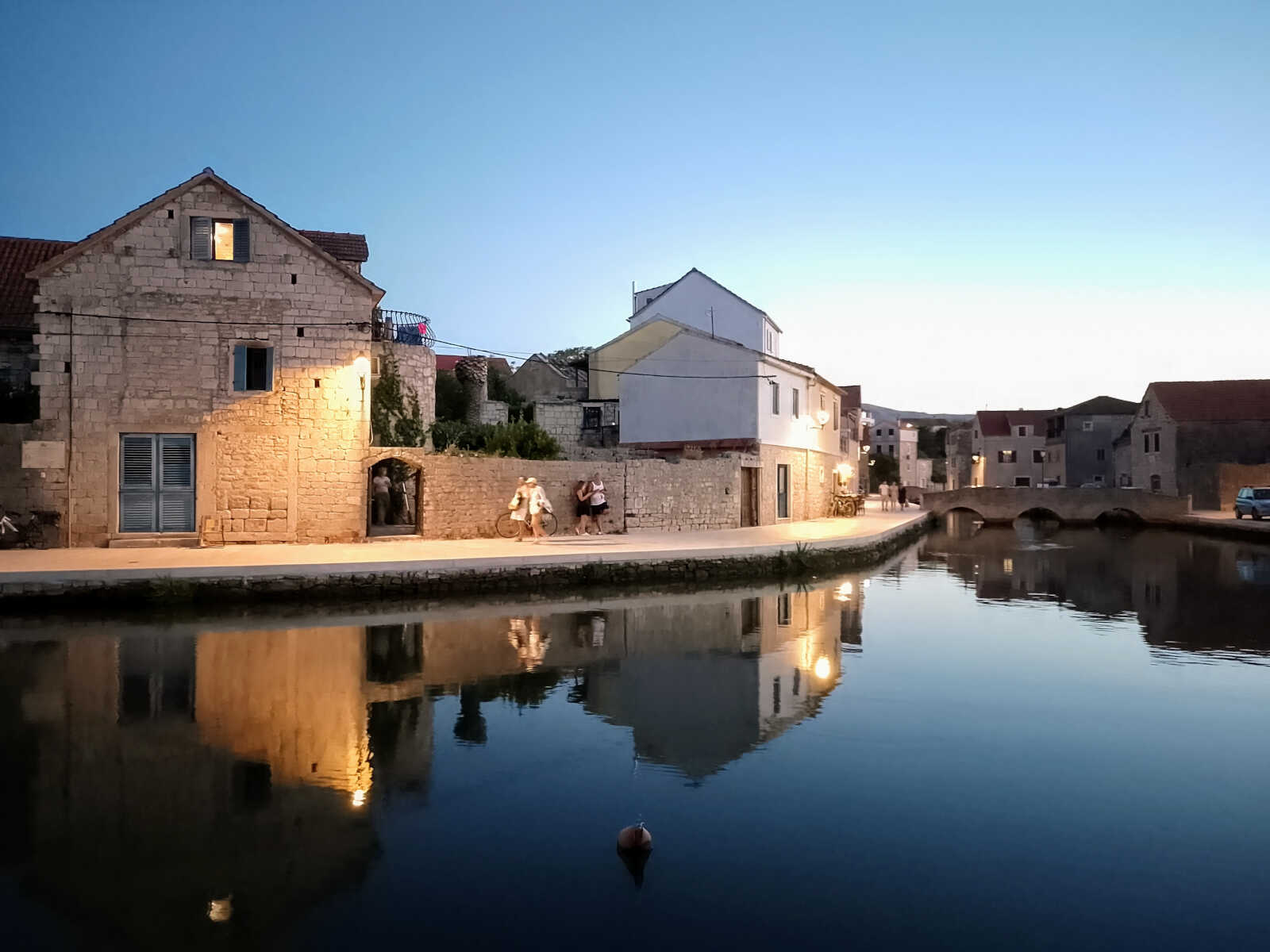
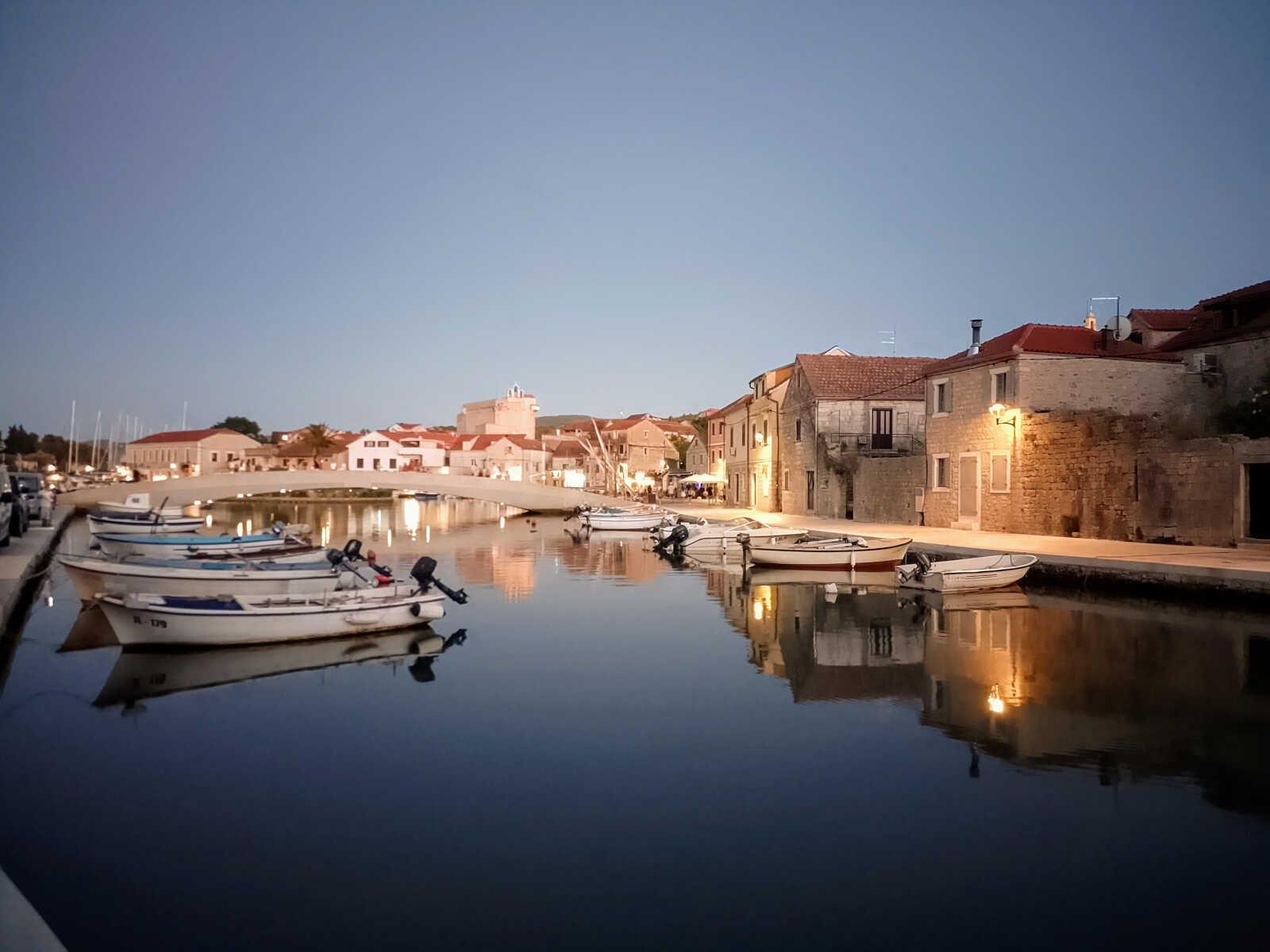
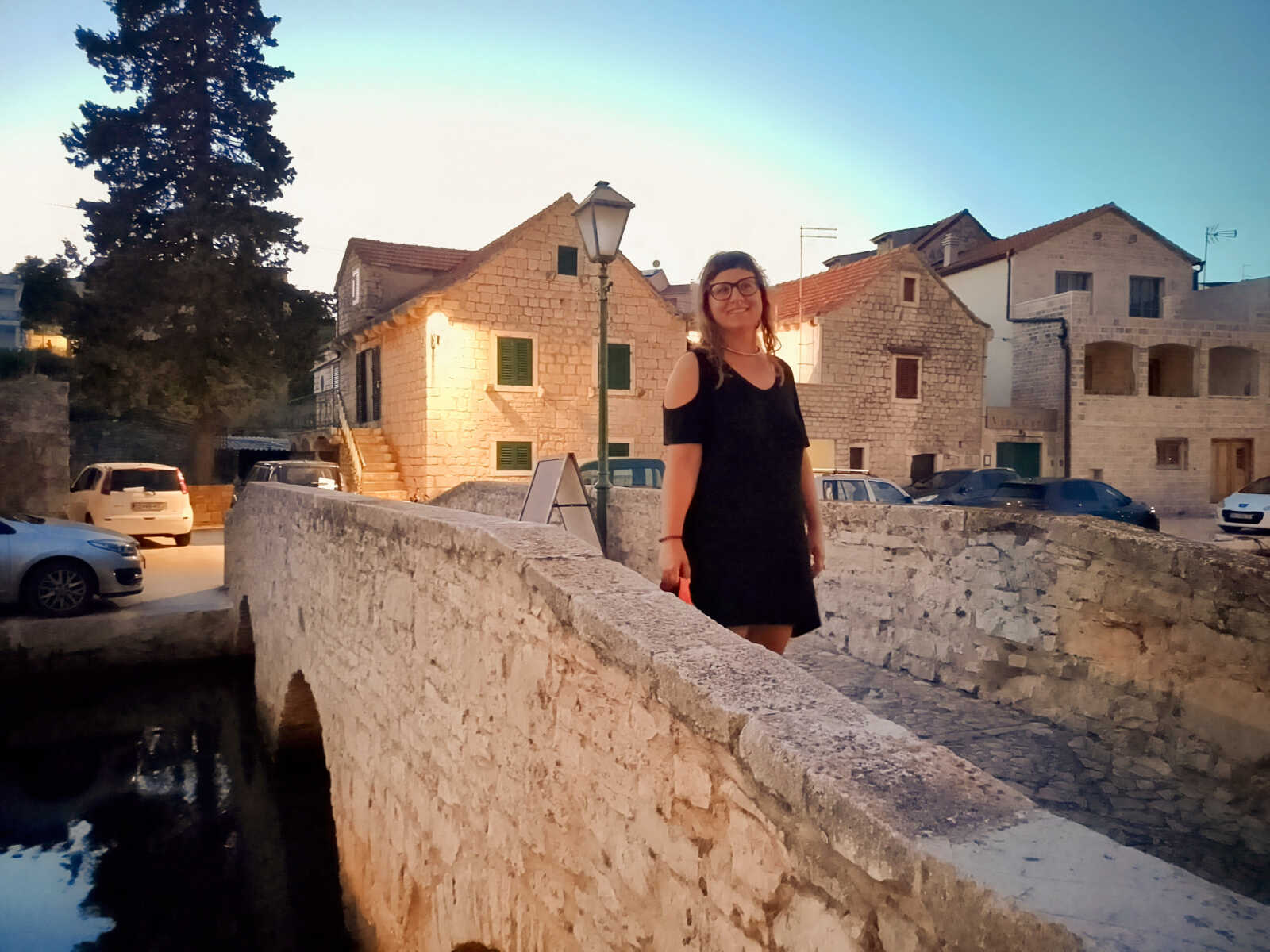
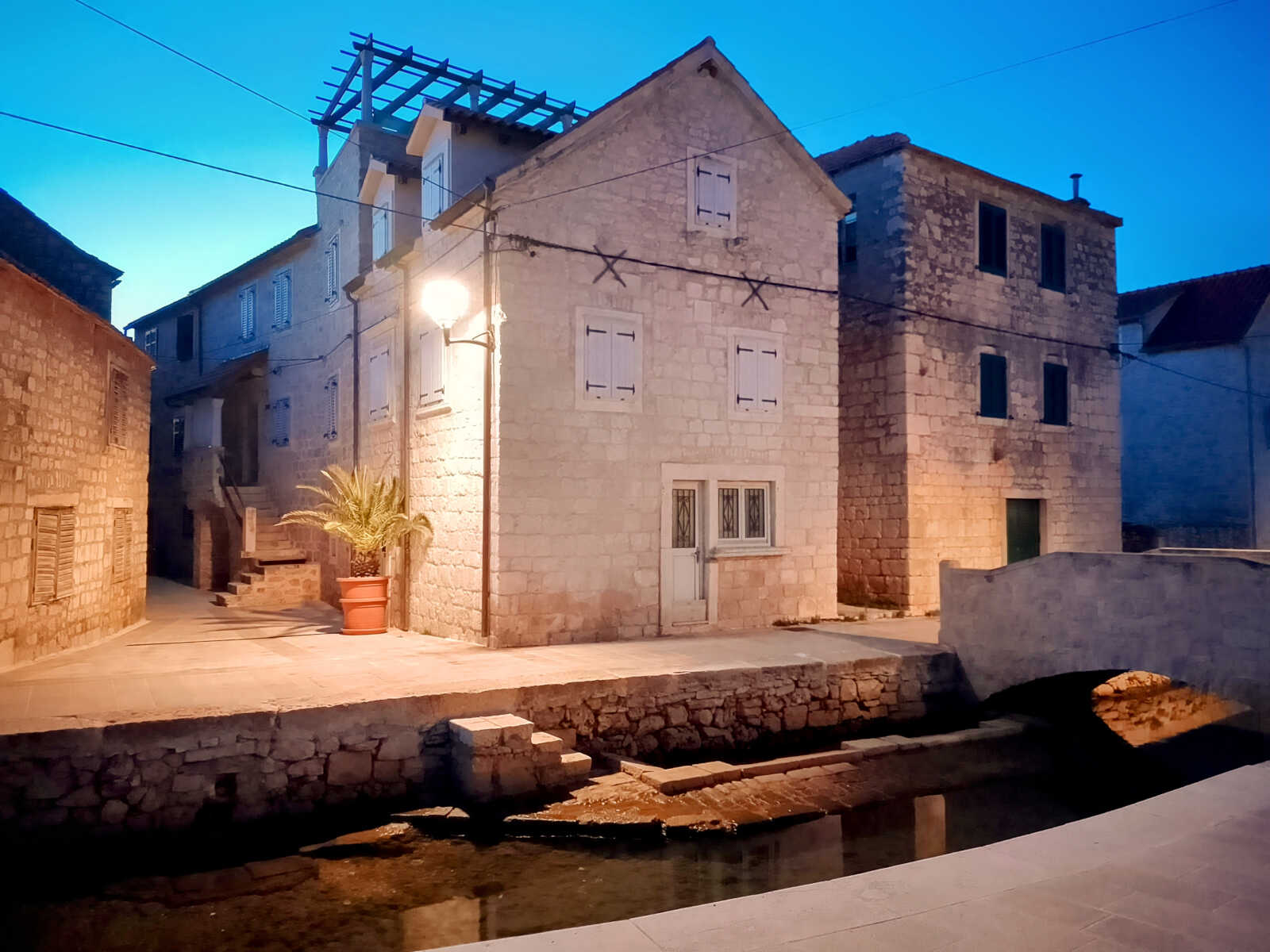
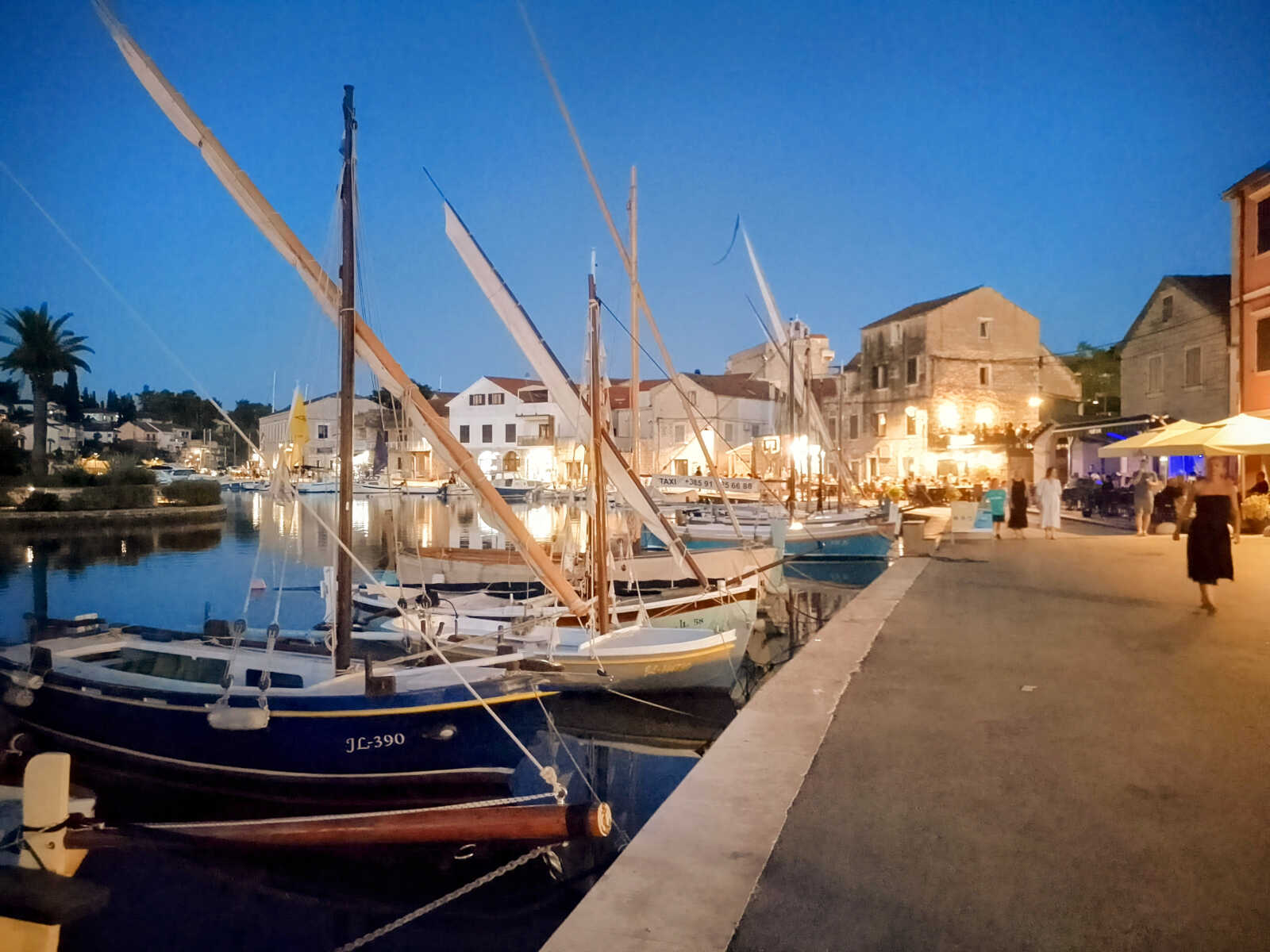
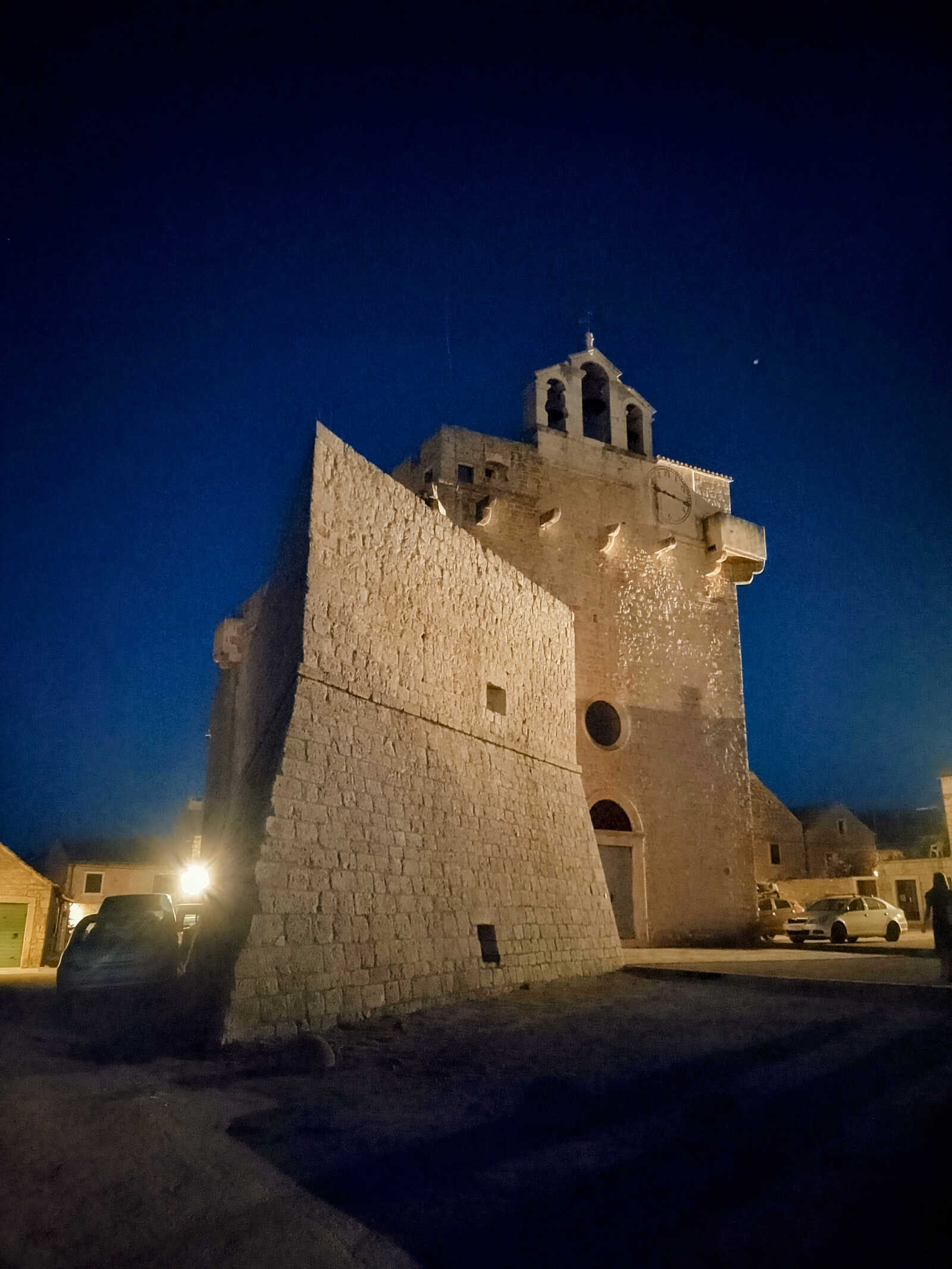
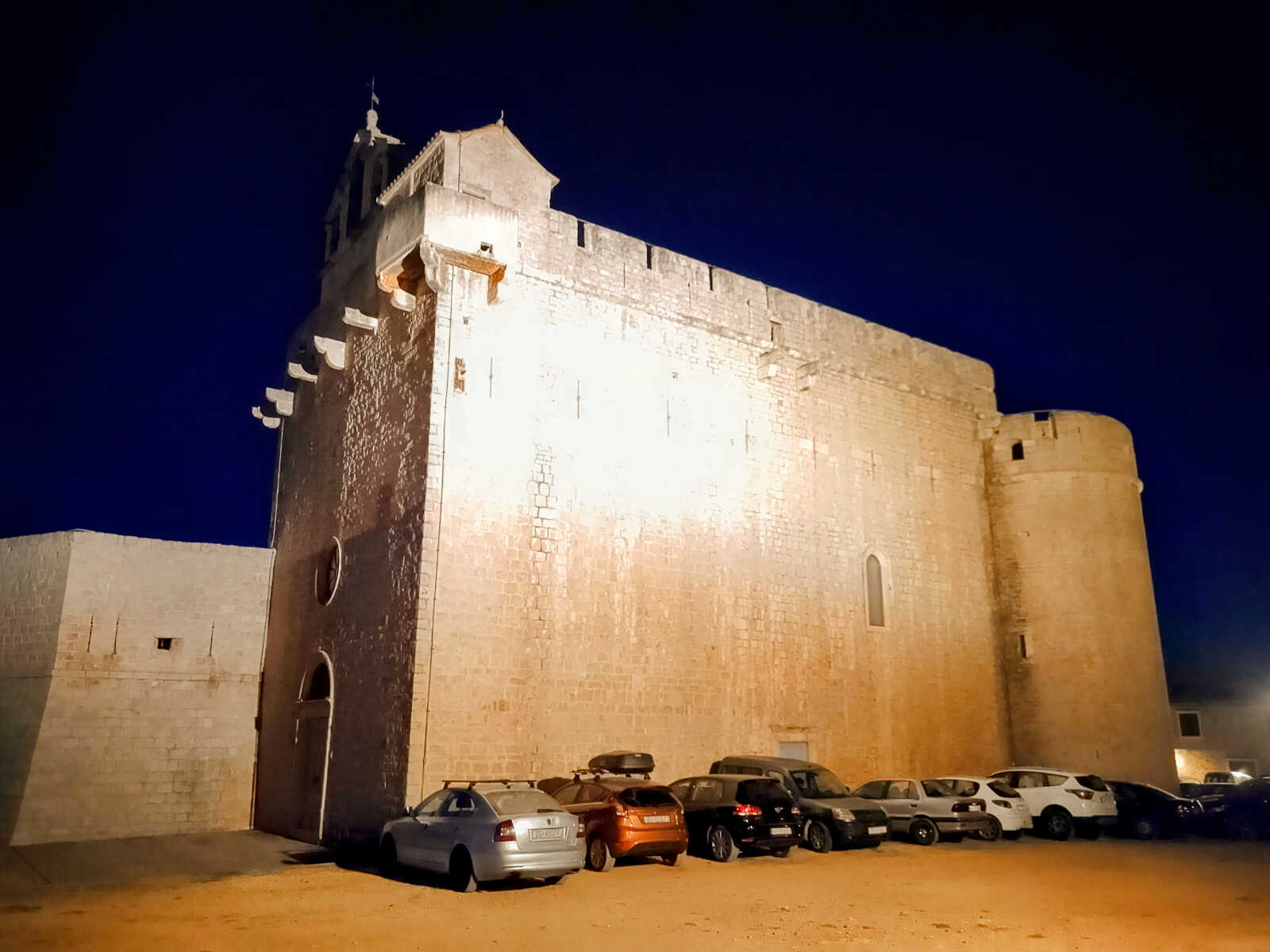
Anche qui una bella atmosfera di paese abitato.
Alla fine ci mangiamo una pizza come regalo di pre-complenno per Melani prima di tornare a piedi alla spiaggia e farci una nuotata di mezzanotte nella bioluminescenza fino a Lilith.
Il giorno successivo andiamo invece dall'altro lato della baia con il tender per una spesa e una visita a Jelsa: anche qui dei bellissimi scorci che non si possono non fotografare.
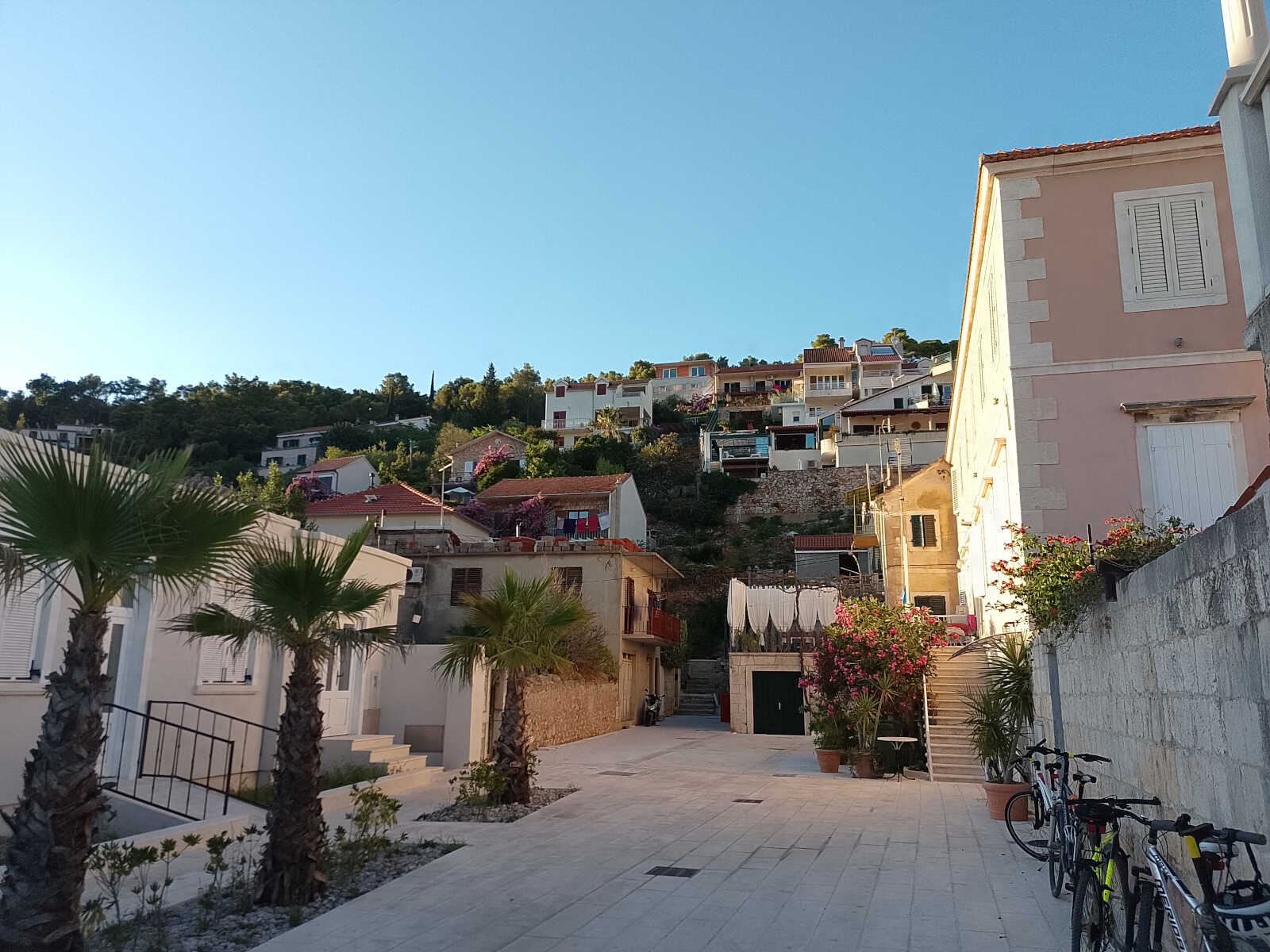


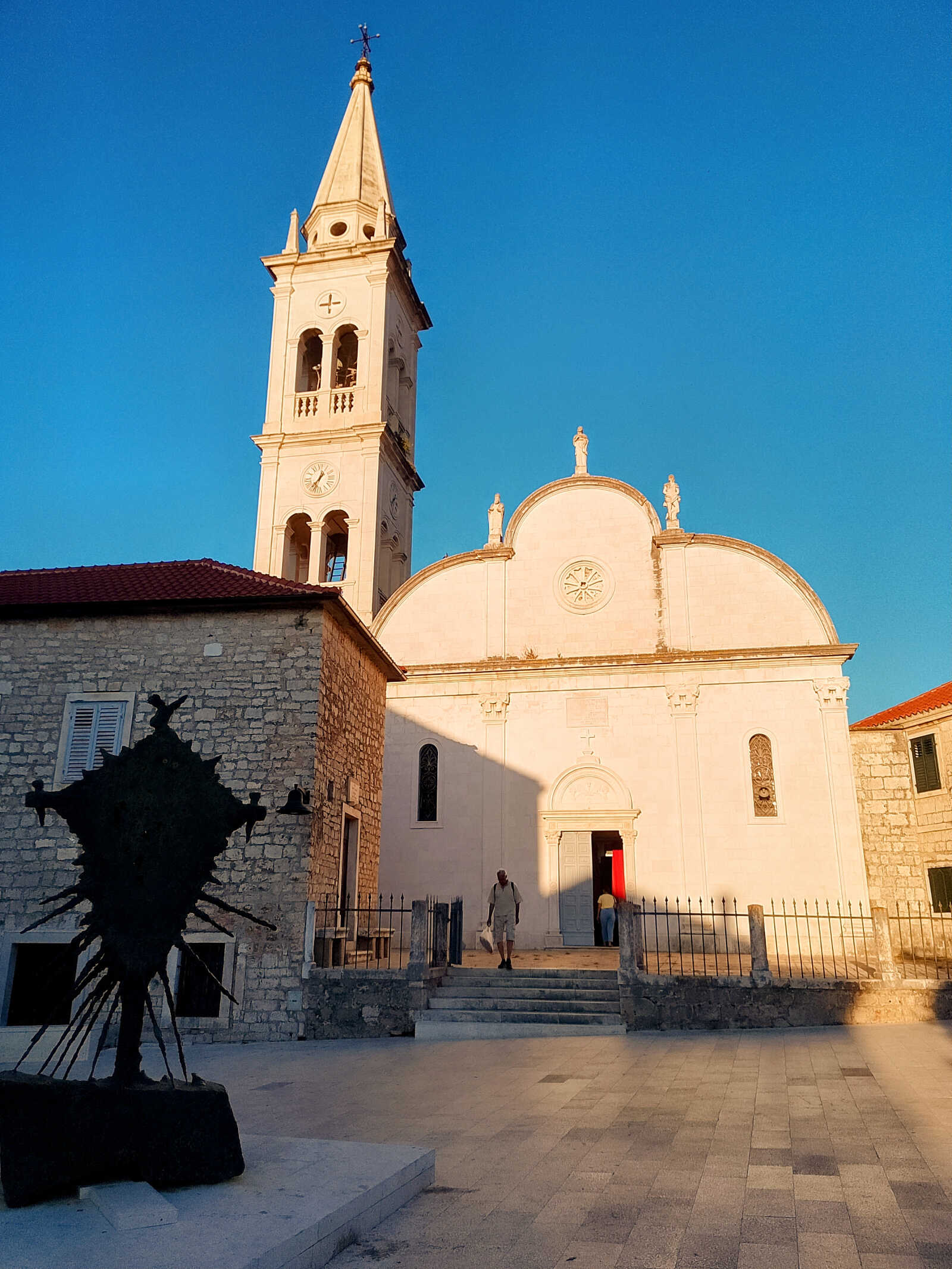
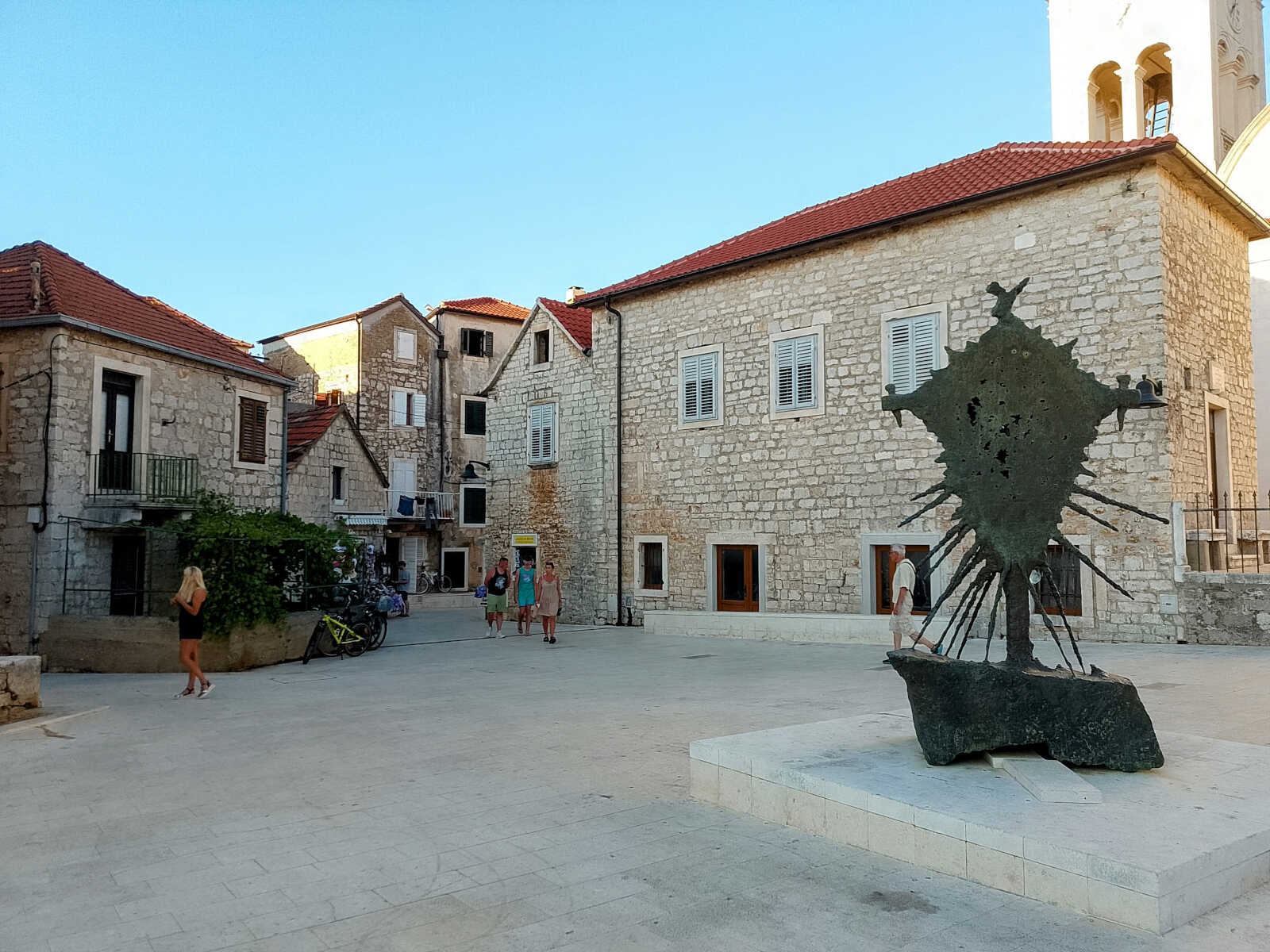
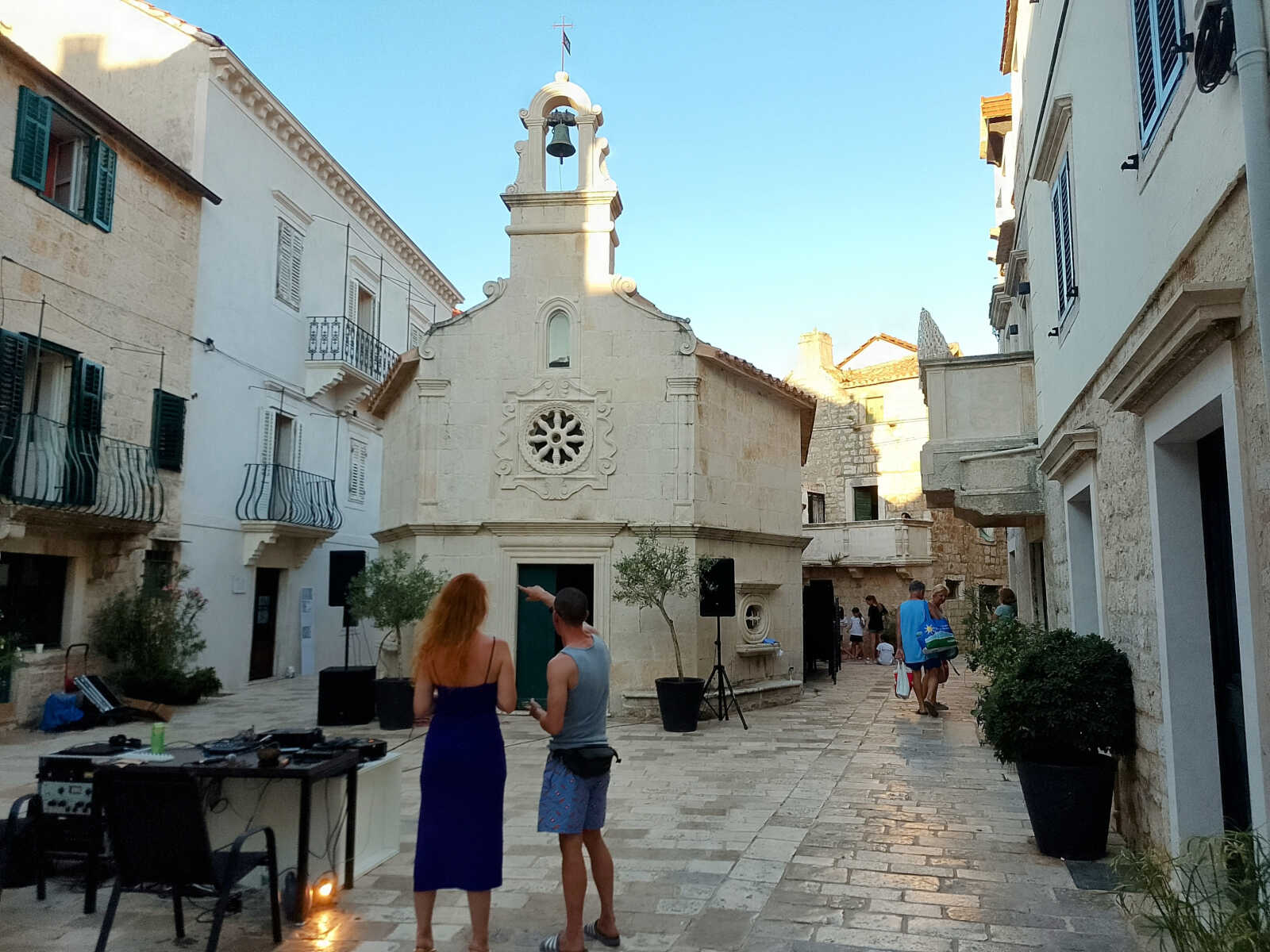
Intanto cominciano a essere previsti dei giorni di maltempo quindi come sempre diamo la priorità a trovare l'ancoraggio più sicuro possibile dove nasconderci.
Decidiamo quindi di passare il compleanno di Melani in navigazione per coprire le quasi 40 M fino a Loviste, una bella baia protetta da tutti i lati sulla punta della lunga penisola di Peljesac che si incunea tra Hvar e Korcula.
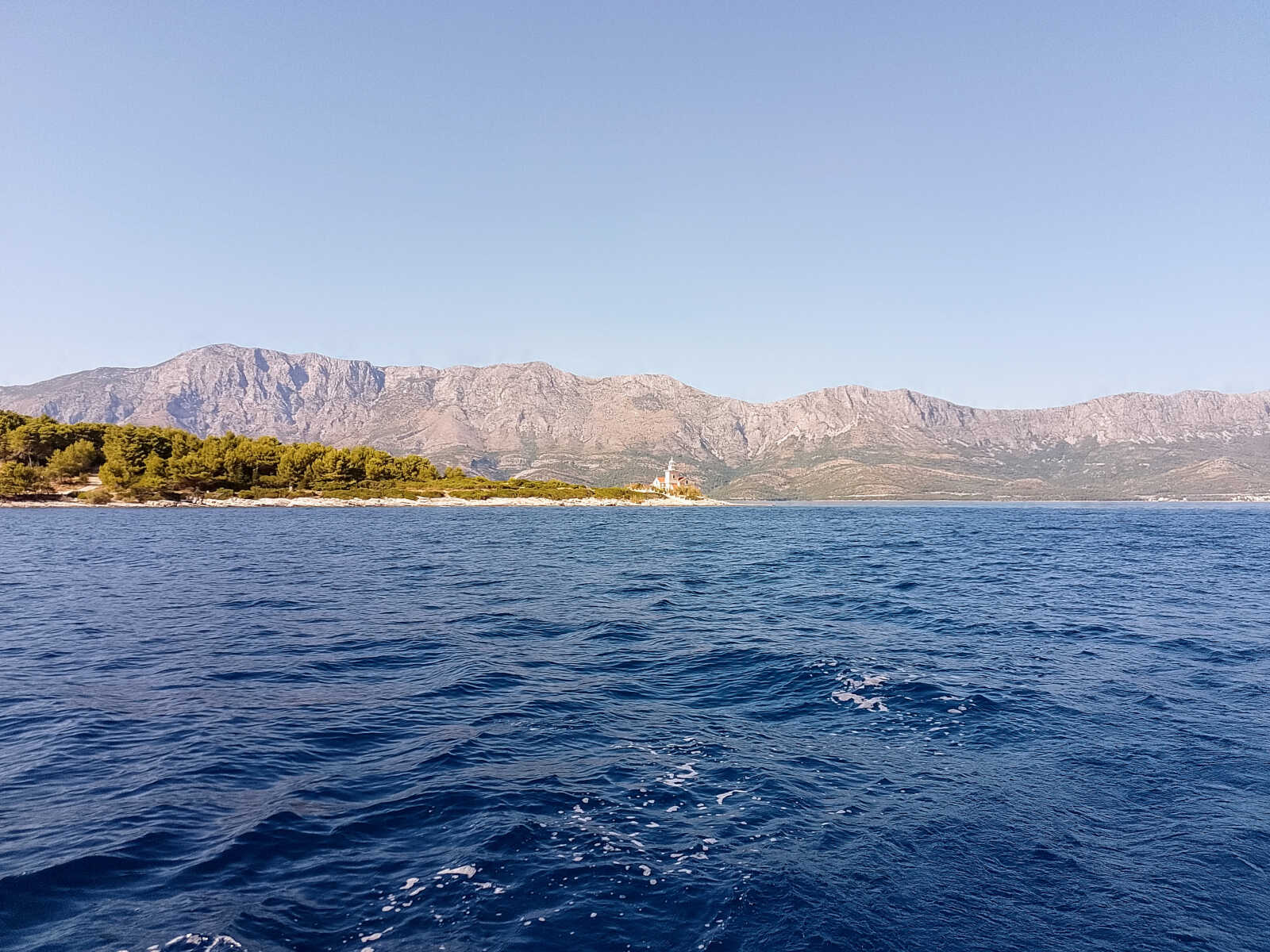
Poco prima di doppiare il capo orientale di Hvar peschiamo per la prima volta qualcosa con la nostra lenza da traina comprata per pochi euro al negozio dei cinese a Ravenna: nientemeno che un tonnetto. Siamo tutti e due increduli ed esaltati. Lo puliamo, sfilettiamo e lo mettiamo in frigo pregustandoci la cenetta di compleanno.
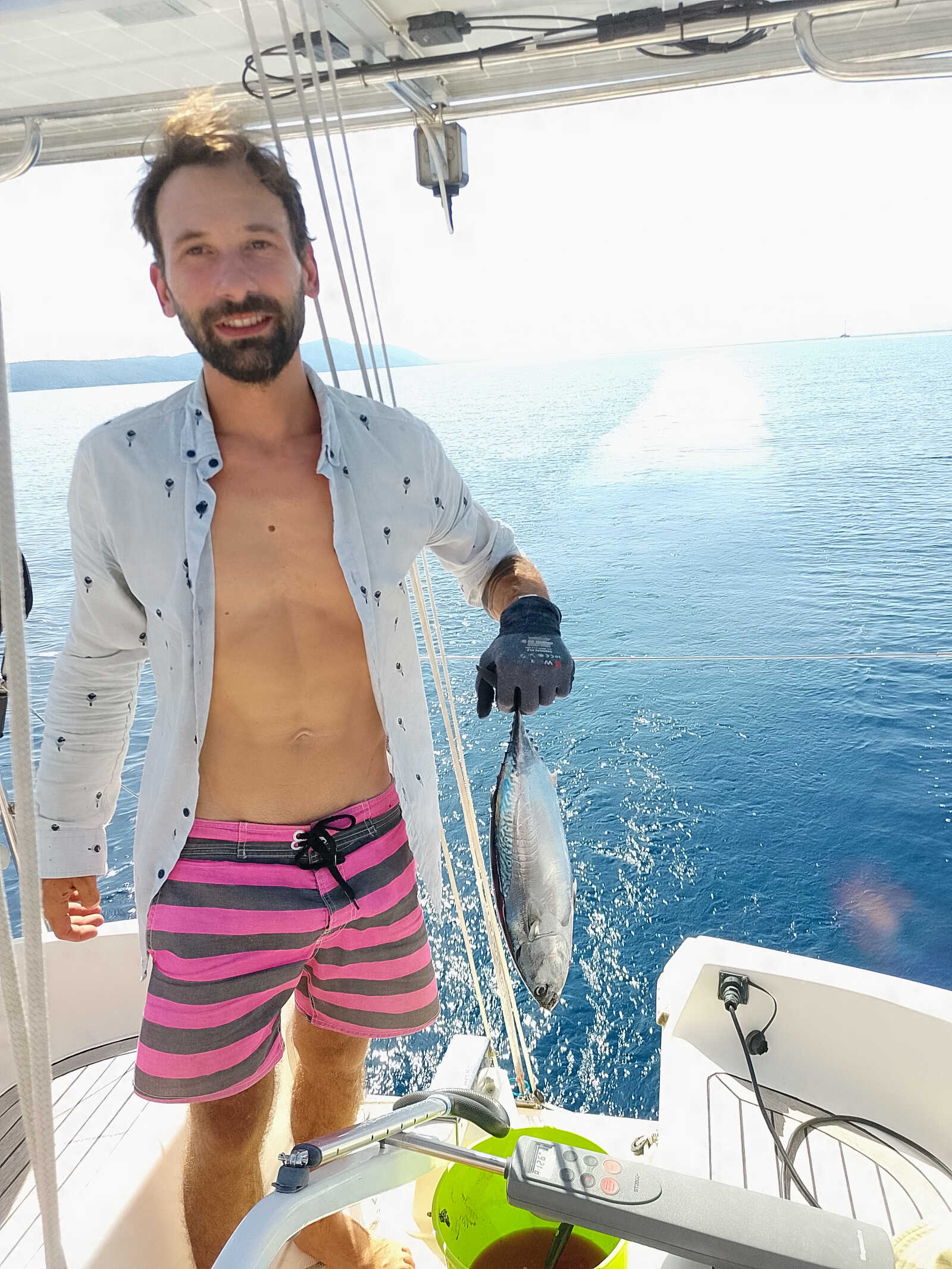
Alle 2020 diamo fonda e dopo una doccia è già buio: le giornate si stanno accorciando.
Scottiamo appena le due bistecche di tonno da più di due etti e mezzo l'una e mangiamo il sashimi dei ritagli più piccoli: il tonno più fresco e più buono che abbiamo mai mangiato.
Il primo giorno di temporali è passato e abbiamo tenuto botta senza problemi e l'abbondante pioggia ha lavato il sale dalla barca.
Purtroppo mentre scrivo ho Melani stesa qui di fianco a me con la schiena bloccata: pian piano si sta riprendendo ma per un paio di giorni non ha potuto fare niente se non stare stesa: i 35 anni si fanno sentire :). Staremo qui fin che non si sarà completamente ripresa.
Ad ogni modo siamo contenti di aver preso una via un po' meno battuta anche al costo di saltare qualche meta rinomata e affollata ma al contempo di avere scoperto delle piccole gemme, qualcuna anche un po' per caso.
Brac and Hvar
27 Jul, 2025
After the long stop in Rogosnizza (8 days!) we were still not sure where to go afterward: we are in the peak of charter season and getting close to Trogir and Split which are the biggest charter bases in this area. From here on we needed to consider the pick up and return days of the charter boats in order to plan our stops avoiding crowded and therefore dangerous anchorages.
In the meantime we decided for an in between stop to get moving: Vinisce was our choice, a small village hidden in a deep bay, almost fjord looking.
We arrived right on time before the afternoon wind increase that in these days regularly reached 25 kn.
Finally we decided to skip Split and Trogir after the Zadar experience and prefer to sail the Brac canal between the main land and the northern coast of Brac, which should be a less beaten path since most of the charters coast along the western side of Brac and Hvar on their way to Vis.
On 12 July we left Vinisce and after a slow start with little wind, we covered the 17 nm in 5 hours to our first anchorage on the western coast of Brac: a lovely small bay with crystal clear water.
Luckily we arrived early enough to sneak in till the end of the bay and anchor in 5 m of water with full swing.

To our shock, boats continued to arrive well in the night: arriving in the dark in an unknown and narrow anchorage is an unsafe practice to say the least.
No matter how nice the anchorage was we decided to leave the next morning, after what we witnessed the day before.
Our next destination was Pucisca, on the northern coast of Brac, but we soon realized that the geografic conformation of this area affected the winds which were never matching with the forecast: the Brac channel goes from W to E and on its northern side (on the croatian mainland) there is a high mountain range right on the coast. These are the Diniric Alps, basically a prolongation of the Alps into the Balcan peninsula (they are the result of the same geological phenomena). This range creates a wall that deflects the wind either East or West in our experience. In this case we had the latter: exactly in the direction we needed to sail.
Never the less we continued to sail closed haul making our sailed distance longer since we had to zig zag (it is called tacking) instead of going in a straight line upwind, which is just not possible with a sailboat.
Suddenly the weak wind became 25 kn and found ourselves tacking our way using the whole width of the channel: we realized we were never able to reach our original destination and the weather was deteriorating so we looked for a back up anchorage.
After 7 hours, 18 tacks and 24 nm sailed we reached U Lovrecina which was only 12 nm as the crow flies.
After a brief rain-shower we enjoyed our dinner and the sundown in the cockpit and while scanning with the binoculars the opposite coastline we noticed a deep canyon in the mountains. After a quick research we learned it was the mouth of a river that it indeed run through a very scenic canyon. At the river mouth is located Omis, a small town which in the past was the stronghold of the Dalmatian pirates. We got curious and decided for a change of plan instead of continuing straight to Pucisca.
While having breakfast a boat for daily trips (looking like a pirate ship) anchored right next to us. After a windless night our anchor was behind our boat right below the tourist ship. We tried to inform the crew and they answered they were going to leave in 30 minutes. As this happened all the tourists were already splashing in the water from the decks. As soon as a bit of wind arose we started to drift towards them as we feared. We quickly decided to leave: we completed the disanchoring maneuver just a few centimeters from the boat while keeping an eye out for the people that kept jumping off the boat.
We finally sailed north for 4,5 nm to the other side of the channel and soon enough we were anchored in front of Omis.
In the afternoon we launched the dingy and we entered the river mouth, went through the river moorings where all the local boats were moored, sneaked under a very low bridge and finally we tried to go as far as possible upriver. In the end we continued for 6 km in the beautiful nature, so different from the bays and sea scenery we got accustomed to in the last months.
The couldn't reach the part with the canyon because we didn't fell like going further with our small 2,3 hp outboard so we headed back to the old town to explore it.
The view of the narrow alleys between the old stone houses and the forts on the slope of the mountain was simply gorgeous.


















We took opportunity for some groceries and a stop in a “pekara” (bakery) for some bread and Burek for dinner.
The day after we sailed 6 nm to Pucisca which is situated in a deep bay of the shape of a snake´s tongue orientated N to S. We anchored in the E tip while the town with its harbor is in the W tip.
These days were really hot so we decided to visit the town in the evening. We walked along the bay´s banks while enjoying a refreshing lavender ice-cream.
The buildings were made of the typical white stone of Brac which is extracted in the quary visible at the beginning of the bay. There is a school for stone masons and its facade was of course finely decorated. This town was another beautiful surprise!








The morning after I got suddenly awaken by the noise of an anchor chain and as we usually do, I sticked my head out of the porthole to check: there was a polish 43 footer only a few meters from us. I run outside still half asleep to get an understanding of the situation: they told me they were having troubles with their engine and not able to move nor lift their anchor. The boats were going to crash so a yelled at Mela to come up to pay out more anchor chain while I was going astern in order to put some distance between us. We made it unscathed once again. To relieve the tension I rowed to their boat to offer assistance. After a while their engine worked again, probably the issue was some dirty diesel.
Beside the rough awakening we decided to leave Pucisca although we originally planned to stay for some days: infact we had an almost sleepless night because of an annoying swell entering the bay.
So we pushed east till Vela Luka. The only thing in the bay were some restaurants that managed a buoy field but managed to anchor in a corner. Here we met an italian couple that invited us for aperitivo and dinner after that we took the time to row till their boat to tell them there was space for their boat next to ours since we noticed they were struggling to get their anchor stuck in the side of the bay where they were. It was a pleasant evening of chatting and exchanging of experiences.
On the 18 we sailed on and we doubled the most eastern tip of Brac and right after it we anchored in a small bay with blue crystal clear water that we had all for ourselves. I went spearfishing with no luck this time around.

The day after we decide to head south across the channel that separates Brac from Hvar: in the next days we were supposed to have southerly winds that would have left us exposed if we decided to stay on the southern coast of Brac. We sailed 10 nm till the beautiful U. Krusela: a scenic bay with really steep rock walls with some marine caves in them. We spent the next 3 days here and we were alone every night: we spent our evenings chatting a starring at the stars in the cockpit.
I take the opportunity for a deep scrub of Lilith´s haul to get rid of some growth. I also went spearfishing and caught 2 nicely sized sea-brims in 5-7 m of depth.

We continued then westward to take some shelter from the forecast westerlies: we anchored in U. Soline. It was a big bay with a space for a lot of boats but it doesn't matter what, you always end up with a too close neighbor.
The first evening we swam to the shore with our clothes in a dry-bag and after a shower on the beach we went on foot to explore Verboska which left us mesmerized by its beauty: lovely old stone houses (slightly different from the ones we've seen so far) were laying along a canal crossed by several bridges which reminded us of Venice, up the hill two XV centuries churches towered the town, one of which was a beautiful example of church-fortress built to withstand the Ottoman raids.








The town has a lovely charm and it felt alive.
We also ate a pizza as an early birthday present for Melani before walking back 30 min. to the beach and swimming back to Lilith in the bio-luminescence.
The following day we motor by dingy to the other side of the bay for some groceries and visiting Jelsa: here as well we find some lovely views that needed to be photographed.






Some days of bad weather started to appear in the forecasts, therefore we gave priority in finding a good shelter. To reach our designated anchorage we decided to spend Melani's birthday in navigation. Right before passing the eastern tip of Hvar we fish a tuna with our cheap lure bought in a chinese shop in Ravenna: we are both in disbelief and excited. We clean it, cut out some filets and put it in the fridge already thinking to the our birthday dinner.

We sailed 40 nm till Loviste a very secure bay protected in all directions, located on the very tip of the very long Peljesac peninsula which stretches between Hvar and Korcula. We arrived at 2020 and we have just time for a shower before it started to get dark: the days are getting shorter.
We sear two huge tuna steaks and we eat the small cuts as sashimi: the best and freshest tuna we ever had!
The first day of storms passed without problems and the copious rain rinsed off the salt from Lilith: clean boat again!
Unfortunately, as I´m writing Mela is laying next to me: she got her back stuck. Must be the weight of her 35 years :) We will stay here as long she will be fully recovered.
We are happy that we choose a less beaten path and that at the same time we could see some less known gems, some of them discovered by chance.